Building the Penntek TR-35

A while ago I saw a review of the Penntek TR-35 and I thought to myself that this could be one of the best options for a super-portable POTA CW transceiver. It is incredibly small, has very low power consumption, has great audio, pleasantly narrow CW filtering, has four bands that are heavily used in POTA (40m, 30m, 20m, and 17m), and is a kit to boot. I ordered one with the optical encoder option (now standard) and then life got in the way and it sat on my shelf for longer than I'd like to admit. Then one weekend I had plans fall through that suddenly gave me unexpected free time, so with a desire to spend some time behind my magnifying glass and soldering iron, I pulled down the TR-35 from my shelf and got to building.
The first thing I noticed was that the kit was organized better than any kit I had ever done. Each step on the manuals had a sealed bag connected on a strip that kept them all together. This eliminated one of the more tedious first steps for building a kit: part inventory. It meant that instead of having a big pile of parts, you only had to deal with what you needed for that step. Absolutely fantastic. The kit consisted of an upper board with the user interface elements (display, knobs, LEDs, and switches), a lower board with the RF components, and a specially made case. Construction started with the upper board and installing the 16 MHz crystal which needed to be installed with a gap from the board. Next came a pin header and the OLED display which was cleverly suspended from the board with standoffs and connected via leads from sacrificial resistors. Then LEDs, capacitors, jacks, switches, potentiometers, and the tuning encoder were added. The assembly was straightforward, although the encoder did require some fairly fine solder work with only a few millimeters between the pins. Finally the switches and knobs were soldered using the front of the case as a jig to ensure alignment. It sounds complicated, but it was fairly straightforward in practice.

The TR-35 Upper Board Assembly
Next came the lower board assembly, starting with the relays and a polyfuse. Then some jacks and potentiometers were added along with some FETs and a series of capacitors. Then it was time for the final amplifier, an IRF510 FET complete with a heat sink, mica insulator, and a plastic spacer to provide electrical isolation between the FET's metal tab and the mounting hardware. This proved to be a tricky step as the initial placement of the FET requires it to be bent over. When I first did this there was enough tension from the bent over leads that even with the plastic spacer the FET was shorting out to ground. I had to disassemble things a bit and bend the leads so that it was no longer pressing against the mounting screw. After a few attempts the continuity function on my multimeter was no longer beeping at me and we had success. The next step was the installation of the many toroids required for the radio. There are many people who do not like winding toroids. I don't mind winding them and find the process somewhat meditative, but I understand how they could be frustrating. For the toroid averse, this kit provides the answer: all the toroids needed are pre-wound at the factory and the enamel pre-stripped as well. If you can install a capacitor on a board, you can install the toroids here. Simple as can be. The toroids were then followed by a bank of 4 filters that needed to have their cases grounded as well. Then we were near the finish line and needed to do a bit of assembly to get the pin headers lined up so that the lower assembly would be electrically connected to the upper assembly. After a lot of solder connections were made, the two boards were mated and the microcontroller was installed and we had an assembled radio.

TR-35 Lower Board Assembly
Now it was time to check my work. There were resistance checks for the 3 power supply rails to ensure there were no shorts, and then I hooked it up to an antenna, power supply, and an external speaker and powered it up for the first time. Right away the display came to life and showed 7030 kHz. I could hear sound too and no "magic smoke" had been released - a welcome result. I went through several tests of functionality ensuring switches did their thing, knobs changed the desired functionality, and then made my way to the encoder. While it could be clicked to change the tuning steps, it wasn't changing the frequency on rotation. Something was wrong. Remembering the tiny pins that needed to be soldered earlier and the fact that it had partial functionality, I powered everything down and disassembled the boards to inspect the pins. I saw some pins that may have been a bit light on solder. I had been conservative on the solder to avoid bridging the fine pins. I gave each pin a bit more solder, gave a continuity test to each pin to make sure I hadn't bridged them, and then re-assembled the board. After getting everything connected the encoder changed the frequency as it should have done from the start. Success.
Next it was time to bias the final RF amplifier, a process that involved using a digital multimeter in current measuring mode to measure the receive current drain (in my case a very small 79 ma) and then to transmit at the very lowest power output which caused the current draw to go up about 11 ma. From there you adjusted to have the draw go up another 5ma and the PA was successfully biased. Further adjustments were made to set the CW sidetone level to a pleasant volume with a potentiometer. One thing that is unique about this kit is the sidetone you hear is actually your transmitted signal, giving you silky smooth QSK. If you're using an unprotected lithium battery, you can even set the voltage for a low power warning. I will be using a regulated supply or a battery with a BMS, so I skipped that step. Finally, you adjust the CW narrow bandpass filter to be properly centered by listening for peak amplitude and then you're done. All that was left to do was assemble the case, install the knobs, LED lenses, vinyl switch covers, and the rotary encoder.
After getting it all together I started spinning the dial around the bands and I was amazed with how low the noise floor seemed to be. The CW signals seemed to pop-out from the background noise and sounded quite pleasant. There are two CW filter modes, one very wide filter around 1.6 kHz and a narrower filter at 350 Hz, albeit with somewhat soft skirts. At the narrower filter setting noise and adjacent signals drop dramatically. I started calling CQ and looked onto the reverse beacon network and saw I was being received well into Europe on the East and West nearly across the US on 40m. Sadly, there were no takers to my CQ, and I decided to give the 30m band a try.

Reverse Beacon Spots on 40m
On 30m I had similar RBN results, getting into Europe and across the United States. I heard a signal about 1 kHz down just faintly as I was calling CQ so I paused for a moment to see who it was. It turned out to be Wolf, DF2PY in Germany calling CQ. I had the pleasure of working him in the past, so I decided to return his call. He heard me gave me a 549 and I heard him a solid 559 and we had a nice chat about home built rigs (he also likes to build rigs) until we were taken out by some QSB. Not bad for a first contact on the rig. In the next day I was able to contact Curacao on 17m as well with 1 Watt. I also made contacts with Oklahoma, Mississippi, Missouri, Pennsylvania, Michigan, Florida, New York, New Jersey, and Central Virginia on the 40, 30, 20, and 17m bands. The rig is a lot of fun, and most of the stations I called I was able to work. I even broke a few POTA CW pileups by going off frequency and using the RIT control to listen to the activator on their frequency, thus making my signal stand out from the zero beat crowd. I am very pleased with the results.
So now that we know it works, what can it do? Well, the power output is variable and somewhat based on input voltage. On the lower bands I can get as much as 9 W out with the output power getting lower as the frequency goes higher. There is an RF output knob that allows you to change your power output, if desired. One thing you notice about the TR-35 is there are no deep menus to learn, almost every function has a button or knob dedicated to it. There are knobs for keyer speed, RF power, RF gain, and volume as well as an optical encoder for the VFO that is smooth and stepless. Pushing in on the VFO encoder changes your step, allowing you to go by 10 Hz and 100 Hz increments with a short press or by 1 kHz increments with a long press. When it comes to switches, you have a power switch, as well as a couple momentary switches that are bi-directional. The first momentary switch allows you to change the receiver mode from wide to narrow bandwidth if pressed up quickly, or to a full SSB width if long pressed. If pressed down it allows you to access the CW memories (there are 2) that are selectable by hitting either the dit or dah side of your paddle. A long press down allows you to program those memories. The final switch allows you to switch bands with a single fast press cycling 40, 30, 20, and 17 and then back again. If you long press up on this switch it will store the current frequency into a band memory. To recall that memory you would press up quickly twice. Finally pressing the switch down engages RIT allowing you to modify your receive frequency while maintaining your transmit frequency. Very helpful for those callers who may be calling you off frequency and not in the center of your filters. This can also be used to allow for split operation, albeit in reverse. Long pressing down will engage a dial lock, useful if you're running a frequency and don't want to accidently go off frequency. There are also LED indicators for signal reception (which shows as blue), red for a low battery warning that is configurable to your preferred voltage via an internal potentiometer, and RIT activation via an amber LED. Another useful feature is that this radio has 2 key input jacks: one for a paddle and another for a straight key. You can have both hooked up simultaneously, in fact in my shack I keep both connected to make for easier tuning with the straight key, or to switch things up if I feel like going manual.
So everything sounds pretty good, right? Well there a few things to note that are missing. There is no internal way of knowing what your output power is, and the output varies by band and input voltage. If you have a wattmeter you could make a table of dial positions and output powers, but you won't see it on the screen. Also, the TR-35 does not have an SWR meter, so you'll want to pack one, or have an antenna tuner available if you plan on using a non-resonant antenna. I have these in my arsenal, so I can deal, but it would be much nicer if the SWR were displayed either on the OLED screen or via some LED metering. Finally, I do get a significant reduction of output on the 17m band, and I've reached out to Penntek to see if they have any idea why this is. I have made plenty of contacts on 17m with the 1-1.5 W I've measured from the radio, but when 40m and 30m are 7-9 W and 20m is about 3.5 W, 1-1.5W is a big drop-off.
All in all, I have been very pleased with my new TR-35. At time of this review they are currently going for $319 as a kit or $419 fully assembled from the Penntek web site. While not the cheapest radio out there, I have been impressed with the quality of the kit and the wonderful sound that it is capable of producing. I look forward to getting it out in the field for years to come.
Posted on January 15th, 2024
POTA Activation #65: A Commute-to-Work 2-fer in DC (DC) (8/4/2023)
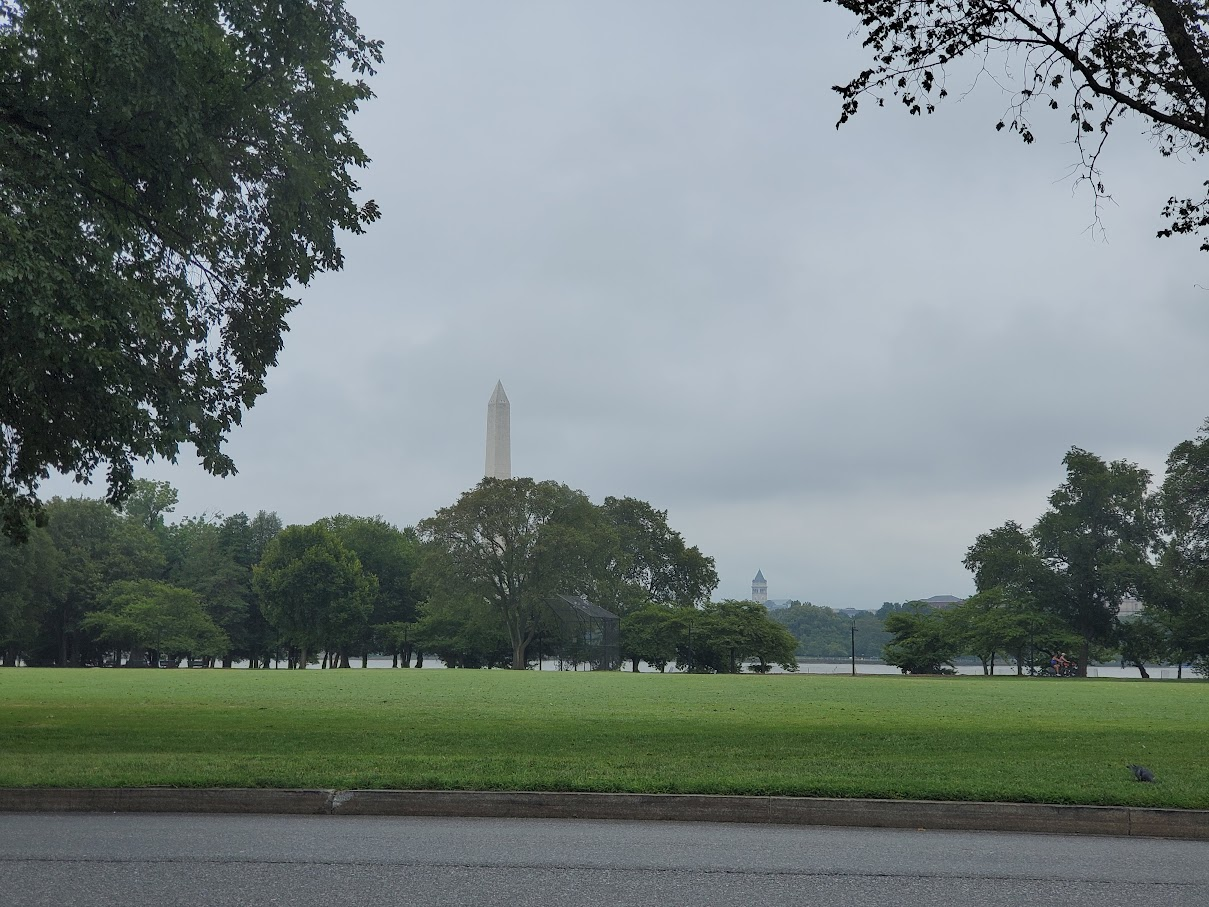
It was a cloudy morning with some intermittent light rain, but somehow I willed myself to get up a bit early with my alarm and the promise of a delicious morning espresso. It had been a while since I had done a morning activation before work and I was definitely feeling the itch to hear the symphony that is a CW pileup that comes when you active Parks on the Air. Thankfully the dreary conditions encouraged other commuters to stay nestled in their beds, so I had almost no traffic as I drove into the District of Columbia. I listened to a few ragchews on the way into work and could tell that the 40m band was working well, so I decided that would be my first band of the day. I also had seen that several of my LICW friends were already up and enjoying their morning coffee and playing radio across the globe, so I was excited at the prospect of getting some of them in the log.
I rolled up to my usual spot and found that Hains Point was closed due to "unsafe conditions". Presumably the recent precipitation had caused some flooding along the drive. I did not despair, as I knew of another spot, not far away, that would allow me to activate another 2-fer along the banks of the Potomac. This time at Captain John Smith Chesapeake NHT and the Potomac Heritage Trail NST. This spot would not be free -- I had to pay a couple bucks to feed the meter -- but with my nominal fee paid to the US Park Service, I sent out a "QRL?" on the empty frequency I had been monitoring, spotted myself on the POTA.app site, and notified my LICW friends that I was about to get on the air.

After a few CQ calls, I heard from a station in Tennessee followed by another in Virginia and then another in North Carolina. Then, clear as a bell, Mike N2PPI came in like he was in the passenger seat from New York, making my first LICW contact of the morning and putting a big smile on my face. Next up, working just a bit up in frequency was super-hunter Dan, WD4DAN who was a solid 559 in Georgia. Always good to get him in the log. Next I heard from Connecticut, New York, Illinois, Massachusetts, and South Carolina. Then I got some more LICW magic from my friend Chris, N8PEM in Ohio. He also had a big signal and I was excited to get him in the log. Everything was off to a great start. Next I heard from Indiana, North Carolina, Michigan, North Carolina again, New York, and finally just up the road in Maryland.
The crowd had thinned and I still had some time, so I decided to try a second band to see what I could do. I set up camp on 30m and called CQ, and for a while heard nothing back. Eventually, I heard from Wisconsin, Massachusetts, Tennessee, Florida, Illinois, Massachusetts, Illinois, and Florida once more. The band definitely seemed noisy though, and some of the signals were down in that noise, so after another lull I thought I would give one more band a try.

With just a few minutes until I would have to head in to the office, I started calling CQ on 20m and initially didn't hear all that much. After keeping me guessing for a bit I heard from Florida, Missouri, Michigan, Florida again, and then I heard a call that initially threw me as it had 2 digits in it ... after a resend I realized it was a station in Belize! Nothing like some DX in the morning! Finally, I got a call from my most prolific hunter, none other than Paul KJ7DT in Idaho, who got in the log for 46th and 47th time! He and I are only 3 QSOs away from an Activator Operator to Operator award. As always it is great to get Paul in the log and I look forward to us hitting that milestone soon. After his call I looked at the clock and realized that I had to call it an activation and get into the office.
After 42 minutes on the air I ended up with 32 QSOs in 2 parks on 3 bands. A great result and a whole lot of fun. Sometimes the early bird really does get the proverbial worm.

Activation QSO Map: Green Pins = CW / Green Lines = 40m, Orange Lines = 30m, Blue Lines = 20m
Gear used in this activation
- Yaesu FT-891
- Yaesu ATAS 120A Antenna
- Begali Magnetic Traveler Light Iambic Key
- 2006 Honda Accord EX V6
- Samsung Galaxy S10+
- HAMRS Logging App
Posted on August 4th, 2023
SV8/N2EC: Working the World (And Some Friends) with Battery Powered CW on the Island of Mykonos (Greece) (7/8/2023)
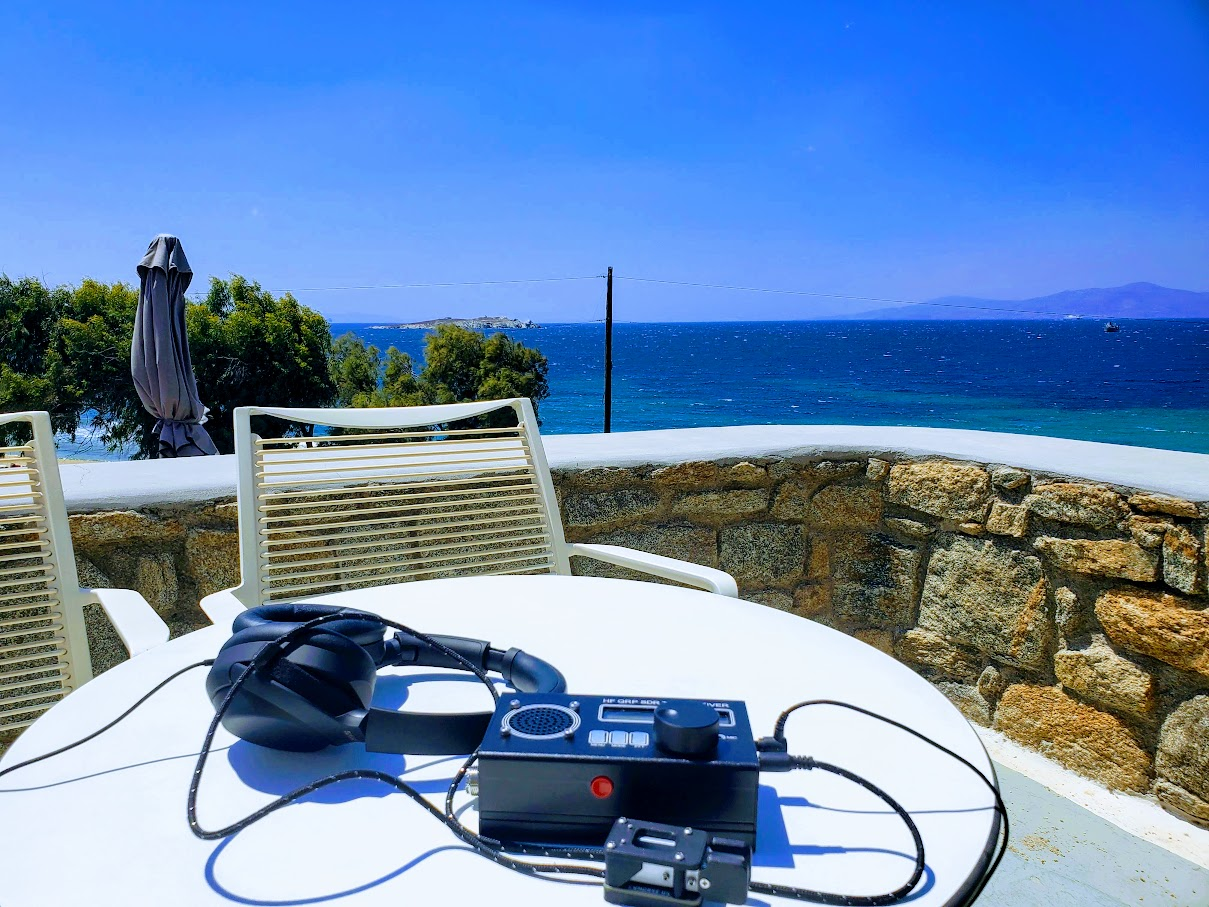
In July of 2023 I visited Greece for the first time with my family. We visited Athens, Delphi, Olympia, Mykonos, and Santorini over the course of two weeks and had an absolutely wonderful time. In addition to visiting the sights I brought along my uSDX 8 Band QRP Transceiver along with my Chelegance MC-750 vertical antenna to see if I could play a little radio while I was there. Since Greece is a participant in the CEPT treaty, my Extra Class privileges allow me to operate as SV8/N2EC as long as I have an official copy of my license as well as a copy of the FCC Public Notice in multiple languages describing the CEPT agreement. My initial plan was to try to activate a park on the island of Mykonos for Parks on the Air. Unfortunately, when I got on the island and talked to the locals, it appeared that the park that was listed on the POTA site was not going to be suitable to activate, so I had to change my plans.

Conveniently, the hotel I was staying at, the Mykonos Beach Hotel, had given us a room that had its own semi-private patio overlooking the Aegean Sea and the hotel's infinity pool. Perfect to use with my vertical and its tripod. Very nice operating conditions! I decided to set up the radio and antenna and see what I could hear. I could hear a lot. I had set up my station in the midst of the IARU HF Championship, so there was plenty of DX on the bands blazing along at the speed of light on CW. After tuning around I decided to contact one of the contesting stations, UC7A, who was coming in strong in Mykonos from Tikhoretsk, Russia, just a bit East of Ukraine. I was happy that I was able to make the trip on my 7.5 Watts.
After tuning around a bit and finding the bands pretty packed, I decided to take refuge in the 17m band and give calling CQ a try to see if I would be picked up by the RBN, and hopefully another station. I was able to see that I was, indeed, getting out with my modest station. I was getting spotted as far North as Estonia, to the Northwest in Great Britain, and to the West in Spain and all throughout Western Europe. After a few calls I heard back from Vlad, UB1AKA, in Saint Petersburg, Russia. We fought the QSB to have a nice ragchew, and Vlad seemed excited to work me in Mykonos with my QRP station. It was a very nice chat and Vlad was very patient as I struggled with the fading. So much fun. Looking at the clock I realized it was time for us to find a place to get dinner, so I broke down the station and we hiked into town to have a delicious meal.
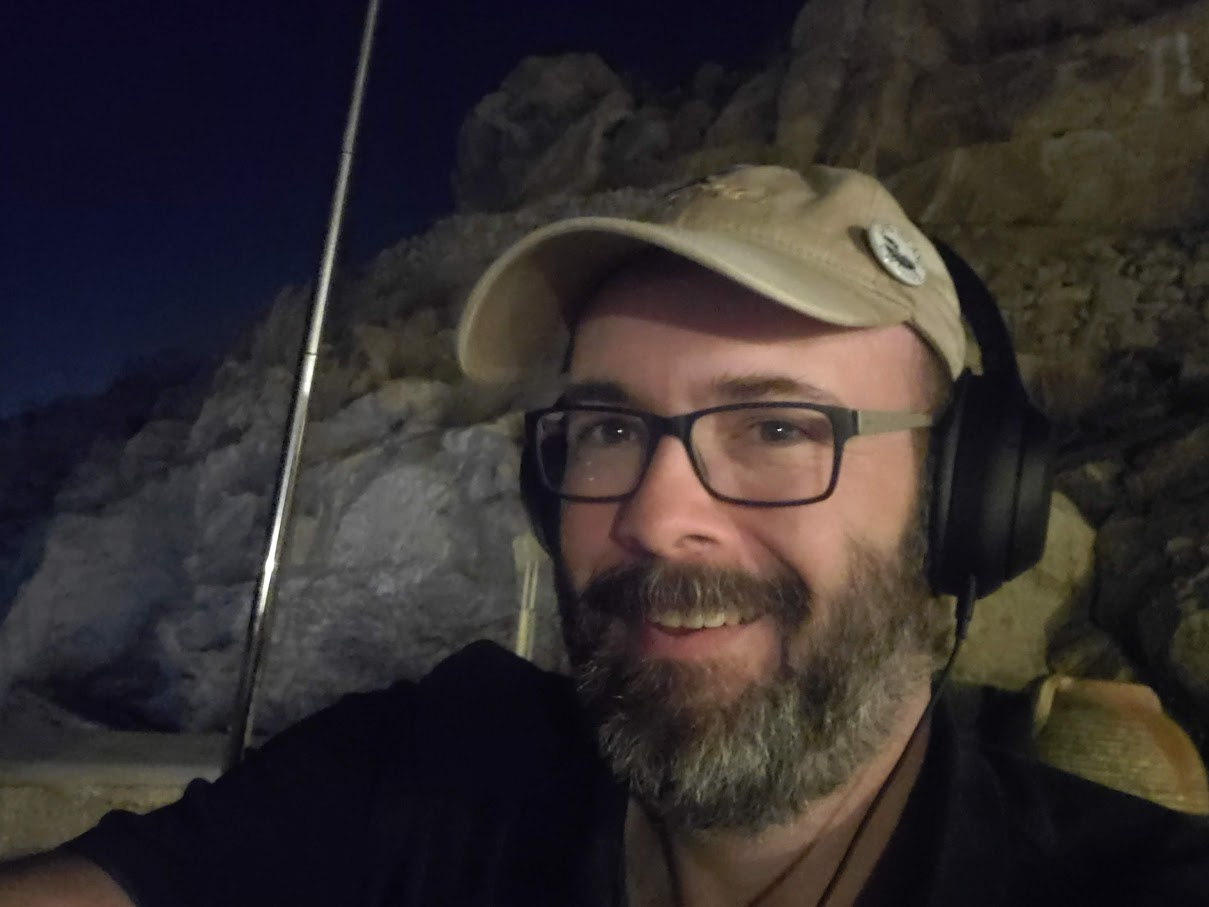
After we returned from dinner, I decided to set the station back up again and see if I could make some more contacts. All throughout my trip I had been corresponding with my friends from the Long Island CW Club on our WhatsApp group, and I let them know I was about to get on the air to see if we could make the impossible possible and make a contact from Mykonos to where they were. I started calling CQ as SV8/N2EC on the 20m band and excitedly listened to the static on the band through my headphones as I watched the lights from the island shimmer on the water of the Aegean Sea.
After a few calls I heard a familiar call down in the noise. My buddy David, SM2YUW, was returning my call from inside the Arctic Circle in Kiruna, Sweden! He and I have become good friends chatting on the LICW DMR group and we had both been hoping that one day band conditions would be right for us to make a QSO without the aid of the internet. Today was the day! Copy was rough, but we were able to get it done. At the peaks we heard each other 559, and we were both giddy with excitement that we were able to have the QSO even though we were around 3,000 miles apart and I was running QRP. Amazing.

Word got around that we made it happen on WhatsApp, and soon I was able to hear another familiar call, this time from 5,000 miles away. Another LICW buddy, Mike, N2PPI, gave me a call from Long Island, New York. He was even deeper in the noise, but I was able to hear him and he was able to hear me down around a 529 RST. I had made it all the way back to the States using 7.5 Watts and a radio I bought on a lark for $139. QRP can definitely be magical. The success was exhilarating for all of us.

But wait, someone tail-ended Mike's QSO with me, this time at a solid 579 from the Netherlands was Jan, PA3CXB. What a night! Jan was excited to work me down in SV8 as well, and I was feeling incredibly lucky to have such a great run on the bands. It was getting late, so I decided to call QRT and break down the station, but it would be a while before I could go to sleep after such an exciting time on the air. I may not have been able to activate a park on the trip, but I can't imagine having more fun than I did contacting friends in the Arctic and the US, and making new contacts all over Europe.
After such a great time on the air, I hope to be able to bring a radio with me on future trips abroad. It really was a lot of fun.
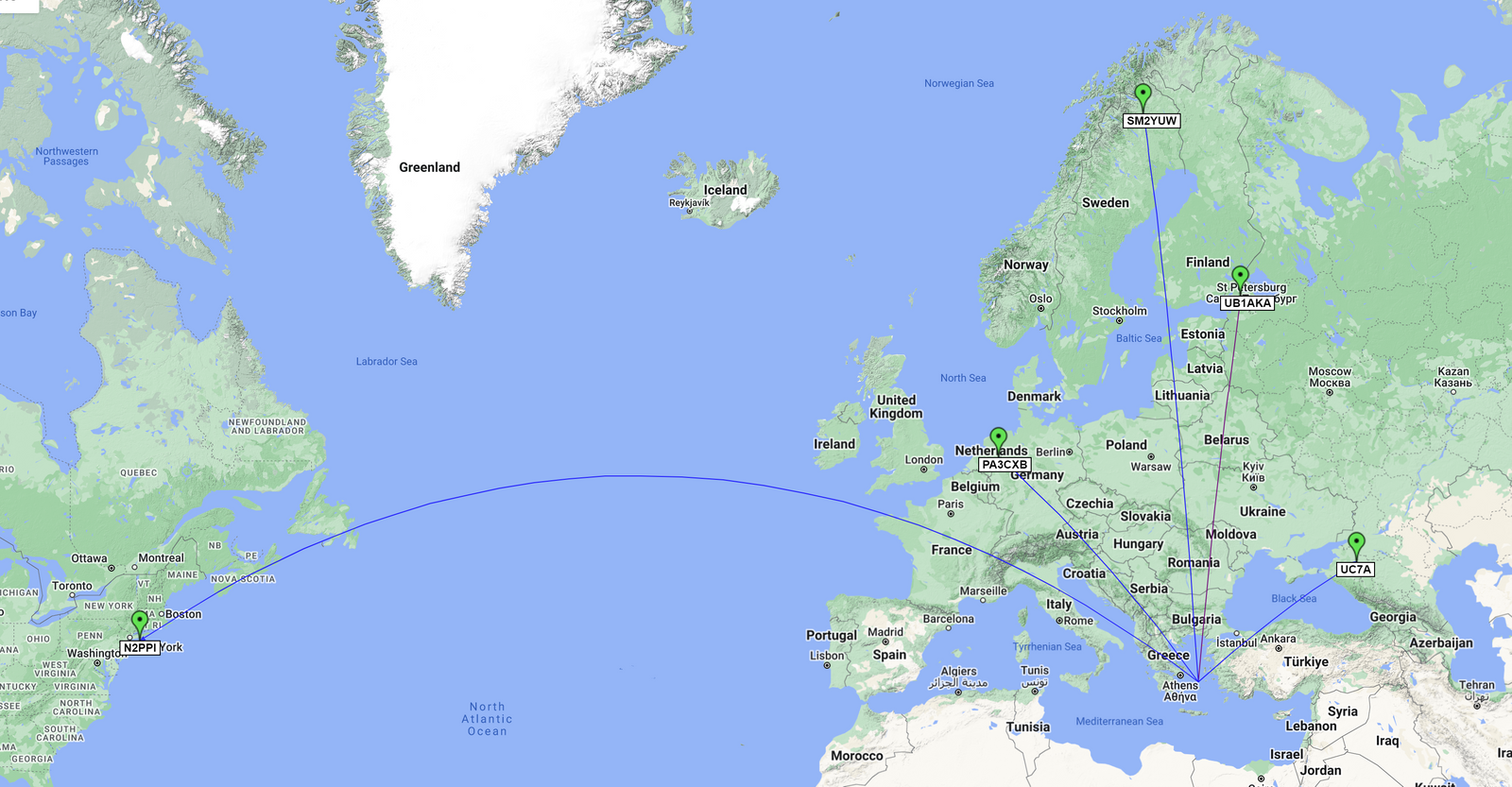
Activation QSO Map: Green Pins = CW / Blue Lines = 20m, Purple Lines = 17m
Gear used in this activation
- uSDX 8 Band QRP HF SDR Transceiver
- Chelegance MC-750 Vertical Antenna
- RigExpert Stick Pro Antenna Analyzer
- CW Morse SP4 POTA/SOTA Mini Morse Code Magnetic Paddle (N0SA Designed)
- Sony WH-1000XM4 Headphones
- Paper Log
Posted on August 2nd, 2023
POTA Activation #64: 4 Park QRP with Gersohn (VA) (7/23/2023)
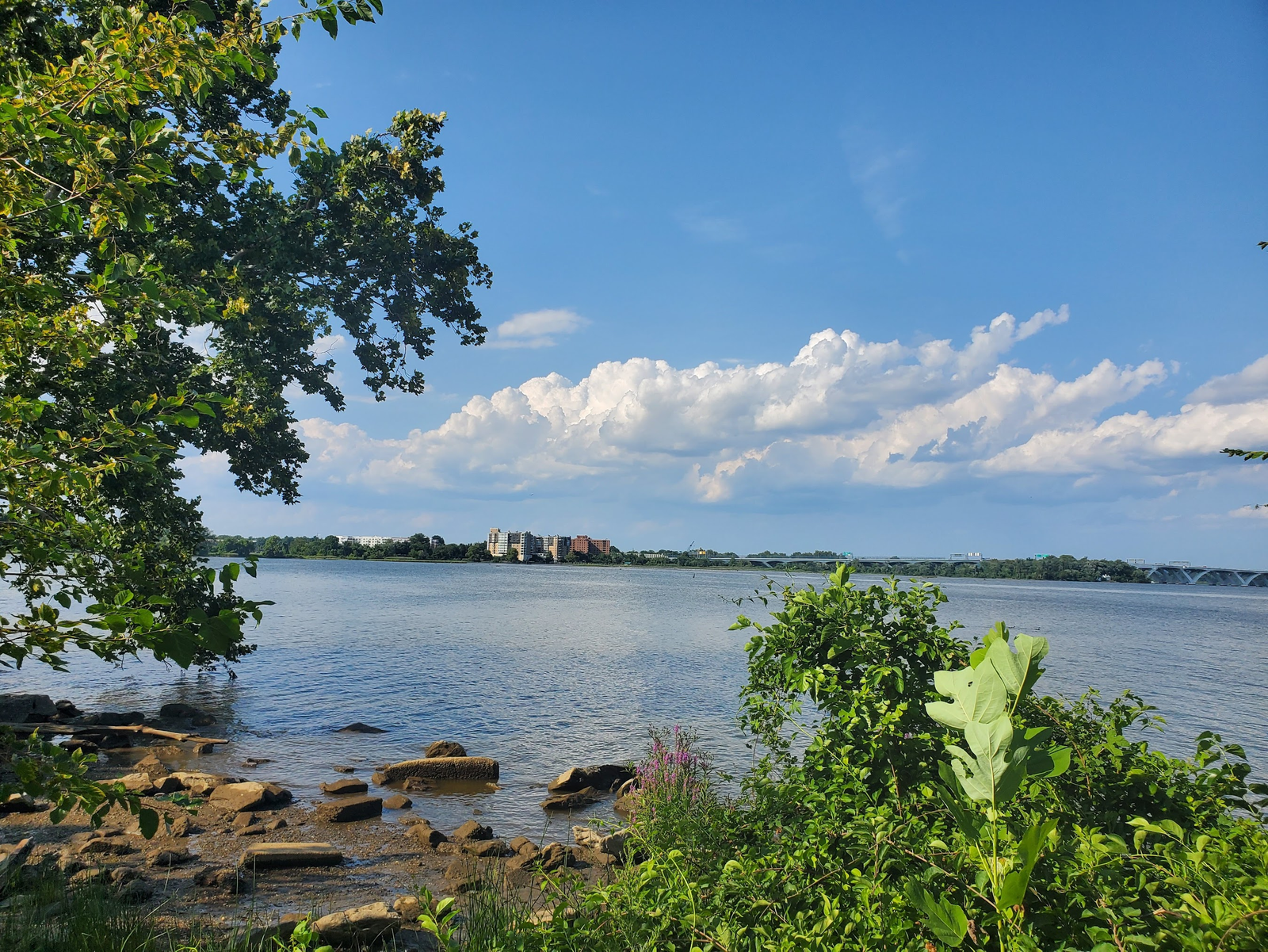
On Saturday my local club, the Mount Vernon Amateur Radio Club, had its monthly breakfast and I got to see my buddy Gersohn, KO4IUK. He suggested that we go out into the parks and do an activation. On Saturday I had a lot of chores to attend to so I couldn't get out that day, but I had a window on Sunday after an afternoon meeting. So we decided to give it a go on Sunday at Belle Haven Park in the George Washington Memorial Parkway, one of our favorite activation sites. It is also coincident with the Captain John Smith Chesapeake NHT, the Star-Spangled Banner NHT, and the Potomac Heritage Trail NST, so it is a full-fledged 4-fer on the banks of the Potomac. My meeting ran a bit late, so Gersohn was already set-up at a picnic table as I was driving over, so I tuned him in on my mobile rig and was able to give him his first contact while I was on my way. It was interesting, from a few miles away he was somewhat quiet, but once I was over a ridge that was between us, his signal got significantly stronger as we became line-of-sight.

Gersohn was using his Xiegu X6100 along with his AlexLoop Magnetic Loop antenna and had setup right by the Potomac in a nice shady spot. After I rolled in I brought my Icom IC-705 and Chelegance MC-750 antenna and as I was setting up I decided to try to activate using the internal battery alone on the 705, something I had never tried before. Using the internal battery (the same ones that Icom HTs use) you're limited to 5W output on transmit, usually I do 10 with the 705. I knew this might be a challenge, as earlier in the day solar activity had caused a lot of D-Layer absorption in the ionosphere, so conditions were a bit challenging. But, as ever, when you're doing Parks on the Air as an activator, you are the DX. So I decided to give it the old college try.

I had the Chelegance MC-750 up and running in no-time, this time using the ground spike into the relatively soft soil of the park. That antenna never ceases to amaze me at how quickly and effortlessly it is able to be setup and tuned precisely. I decided to start on the 15m band, in the hope of bypassing some of the problems relating to D-Layer absorption, and using the in-built markings the SWR was pretty much spot-on from the initial setup. I used my antenna analyzer for the first band, but for subsequent tunings I found just by moving it near the markings I had a sufficient match to just use the radio itself. Nice. As has been my recent custom, I put out a notification on the LICW WhatsApp group to let my friends there know I was going on the air and I started calling CQ. After calling CQ for a while, it became clear this might not be an easy one. After a few minutes I heard from Jerry, WB7S, in Wyoming, an LICW member on the WhatsApp group who came in with a very strong signal on my end at 559 and was doing more work to get me with a 339. Was great to get started with an LICW friend. Unfortunately, that would be the only 15m contact I would get.
After about 13 minutes of calling CQ without an answer, I moved on down to the 17m band and heard a familiar call, KJ7DT in Idaho, who gave me my first reply on 17m. Two minutes later I got a call from Florida that came in nice and loud for me but reported me down at 229. Glad they did the work to copy me. After another 5 minutes I got a station in England that similarly was blasting in, but heard me a 339. Always great to get across the pond ... and with 5 Watts, no less. I'll take it.

After another 7 minutes of CQing into the void, I decided to take my chances with the D-Layer absorption and move on down to the 20m band to see if one of the two workhorse bands of POTA could pull me back from the jaws of defeat. Sure enough, I was getting some distance with my 5 W as my first two replies were all the way from Washington state! Next I heard from Texas, Florida, Illinois, Minnesota, Texas (twice), Indiana, and Florida. I had tried to call QRT for a bit, but I kept being called afterward, so I ended up making more than just the activation requirement. Once I got a break in calls I shut down for a while to allow Gerson to get some more operating time in to see if he could finish his activation, too. He was making contacts with the AlexLoop, but things seemed to be going a bit on the slow side, so he decided to hook up to my Chelegance MC-750 and the calls started picking back up. In short order he made his activation and another successful one was in the books. He started to shut down, but I wondered if I could get some of the LICW friends who had been having trouble hearing me on the higher bands.
So I tuned the antenna to 40m and decided to give another go at it to see if I could get some more close-in friends in the log. Right away I heard from Michigan, Virginia, Massachusetts, Ohio, and then I got LICW buddy Chris N8PEM booming in from Ohio! I was very pleased to get him in the log another time. I was coming in 559 for him, but still doing well for 5 W. In fact I was getting great signal reports on 40m, and looking later it looks like the sun started to stop its tantrum of charged particles, so the bands were shaping up. Next I heard from New Jersey, South Carolina, West Virginia, Virginia, Indiana, New Jersey, Arkansas, Tennessee, Wisconsin, and finally New Jersey. Once again I had tried to call QRT so I could pack up and chat more with Gersohn, but once again (actually about 4 times again) after calling QRT I got more callers, and I hate to leave people hanging.
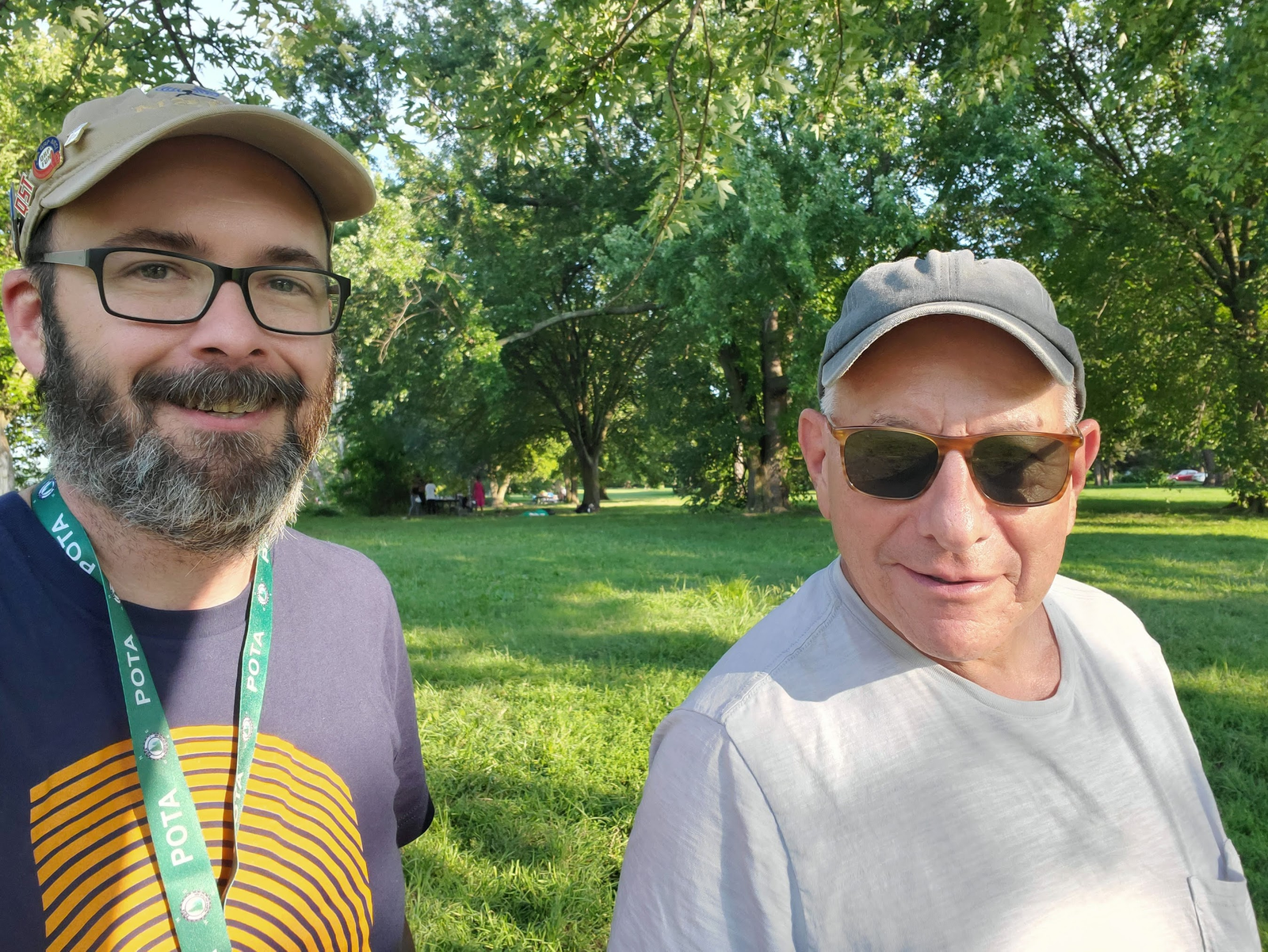
By the time I shut off the radio I had made 30 CW QSOs on 4 bands over the course of 2 hours and 5 minutes. Since I took a break in there while Gersohn was finishing up his SSB activation, actual time on the air was about 60 minutes. Considering I was at 5 W, not bad at all. If I had stuck around later on I probably could have gotten a lot more as the rate seemed to be escalating quickly, but dinner time was calling. I had a great afternoon out with Gersohn in one of our favorite operating spots. As we packed up we discussed some plans for our next rove together. We need to work out the logistics, but if we can pull it of, it will be one to remember. Definitely stay tuned, you won't want to miss this one. Until then, 73.

International Activation QSO Map: Green Pins = CW / Green Lines = 40m, Blue Lines = 20m, Purple Lines = 17m, Cyan = 15m

Domestic Activation QSO Map: Green Pins = CW / Green Lines = 40m, Blue Lines = 20m, Purple Lines = 17m, Cyan = 15m
Gear used in this activation
- Icom IC-705
- Chelegance MC-750 Vertical Antenna
- RigExpert Stick Pro Antenna Analyzer
- Begali Magnetic Traveler Light Iambic Paddle
- Icom LC-192
- Samsung Galaxy S10+
- HAMRS Logging App
Posted on July 24th, 2023
POTA Activation #63: A Support Your Parks Weekend 4-fer (VA) (7/16/2023)

Four times a year, Parks on the Air has a special weekend where activators are encouraged to get out into the parks for what they call "Support Your Parks Weekend". I always try to get out at least once to activate during those weekends if I am able to do so. I had just gotten back home on Saturday from a two week vacation to Greece, so I was still recovering a bit from the jet lag, but I had some time in the afternoon and I had the itch to get out into a park and make some contacts. So I went to one of my favorite 4-fers along the banks of the Potomac River inside the George Washington Memorial Parkway to activate GWMP, the Captain John Smith Chesapeake National Historic Trail, the Star-Spangled Banner National Historic Trail, and the Potomac Heritage Trail National Scenic Trail. In the interest of keeping things simple and being time efficient, I decided to make this one a mobile activation.

I decided to start on 20m and began hunting a Park to Park in Missouri. After making the contact I set up camp just above his frequency and started calling CQ. My first response was from KJ7DT in Idaho who always is good at making hunting magic, it would not be the last time today that he would be on my log. Then I heard from Wisconsin, Tennessee, Arkansas, Texas (3 stations in a row), Florida, Illinois, Florida, Colorado, Illinois, and Florida again. Then I heard a weak signal that I could hardly believe. It was KL7AC in Alaska giving me a call, 539 both ways, but man I'll take that any day. Some fantastic DX. Then I heard from Ohio and Tennessee and then things slowed down for a bit. After a few minutes I heard from DL2COM in Germany who came in at a 529, but we made the contact, more DX magic. After some more quiet, I switched to the 17m band and called CQ for a while but heard nothing but noise for a while until KJ7DT in Idaho broke the silence just above my noise floor at 529, he heard me a bit louder at 559, and he was in the log again. Next I heard from California after a few more CQs, and then crickets. It was time for another band, so I moved down to the 30m band and right off the bat I heard from Maine, Arkansas, Illinois, Florida, Wisconsin, and Georgia.
Next I heard a solid loud signal from a familiar call, KK4WDP, my friend Josh who was just a few miles away in Alexandria. I told him it was great to get him in the log, and then heard from Tennessee, Florida, Arkansas, Florida, and Tennessee. The contacts started to slow down a bit, and I hadn't been heard by some of my LICW friends who I knew were looking for me, so I decided to hop down to the 40m band to see if I could make it up to New York. In a word, yes. Contact number one on 40 was Ed, N2GSL, coming in a solid 559 and sounding great from NY. Always puts a smile on my face to get Ed in the log. Next up was Wisconsin, Michigan, and South Carolina. Then I heard from Karl K5KHK up in Rochester, NY who I got to meet at FDIM this year, and another station in New Jersey. That was followed by another LICW buddy Mike, N2PPI on Long Island, NY who I was excited to get into the log again. I had the good fortune to work him when I was on vacation in Greece while operating patio portable on battery power. Next up was South Carolina and another New York station followed by yet another LICW buddy, Chris N8PEM who had been activating a few SOTA summits earlier in the day and was doing his first POTA activation of the day. He came in like he was sitting next to me from Ohio and I was glad we were able to make it happen. I would try to hunt him later on 20, but would only hear the Spanish DX he was working at the time, and not him. Very glad to get him in the log on 40.

Next I heard from Georgia, New York, Massachusetts, South Carolina, Ontario (Canada), a Virginia station just down the road in Woodbridge, and then I heard Josh again, KK4WDP, for a second band just down the street in Alexandria. I thanked him for another one and then heard from another Virginia station, then Ohio, Michigan, North Carolina, and then finally a pair of Virginia stations before things got quiet again. I looked at my clock and saw it was getting late and I had been out for 90 minutes already, so I called QRT and called it an activation. By the end I had made 55 CW QSOS ranging from Alaska to Germany. So much fun. With a 4-fer, that was another 220 in the log and another Support Your Parks Weekend in the books.
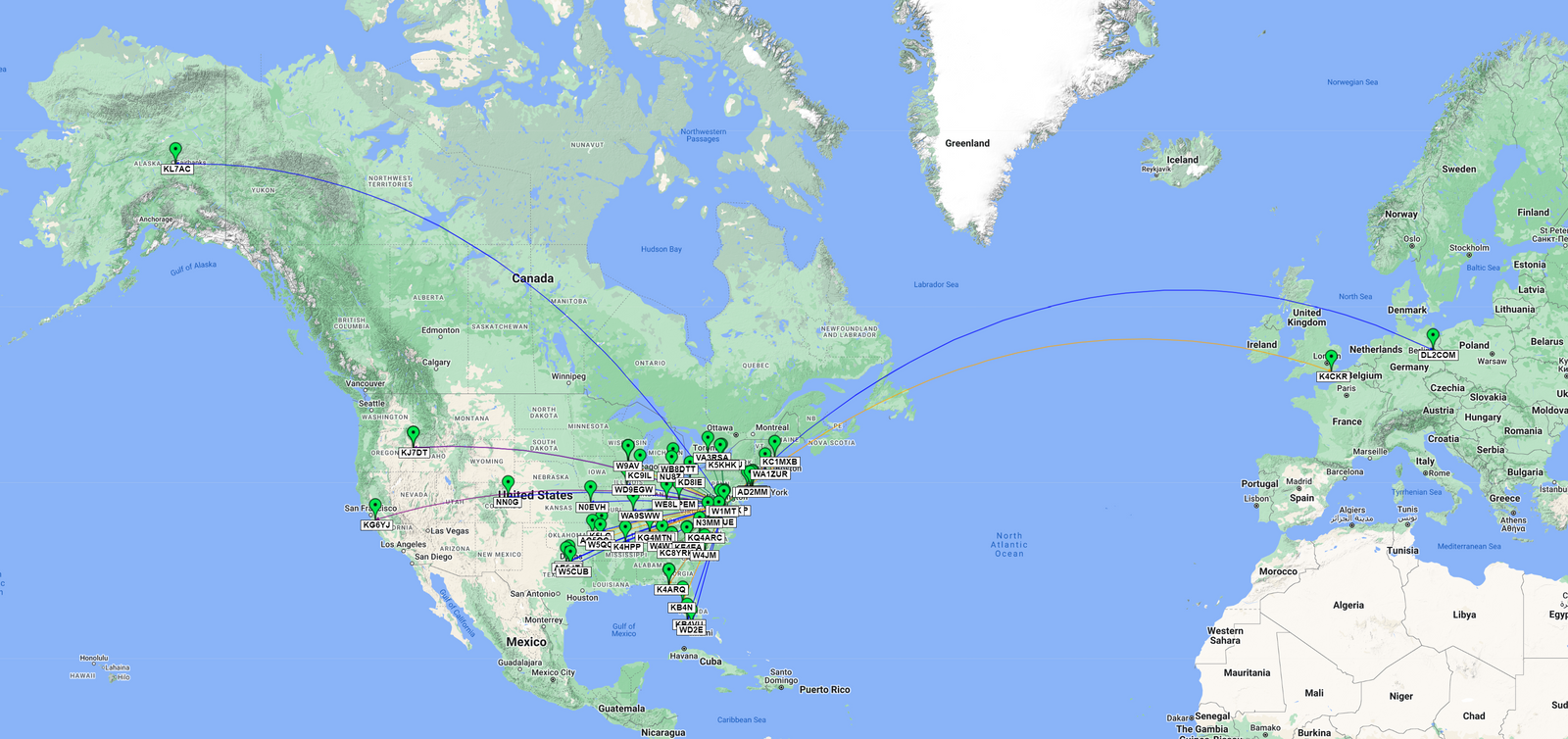
International Activation QSO Map: Green Pins = CW / Green Lines = 40m, Orange Lines = 30m, Blue Lines = 20m, Purple Lines = 17m

Domestic Activation QSO Map: Green Pins = CW / Green Lines = 40m, Orange Lines = 30m, Blue Lines = 20m, Purple Lines = 17m
Gear used in this activation
- Yaesu FT-891
- Yaesu ATAS 120A Antenna
- Begali Magnetic Traveler Light Iambic Key
- 2006 Honda Accord EX V6
- Samsung Galaxy S10+
- HAMRS Logging App
Posted on July 18th, 2023
POTA Activation #62: A QRP 4-fer Activation Testing a New Rig (VA) (6/17/2023)
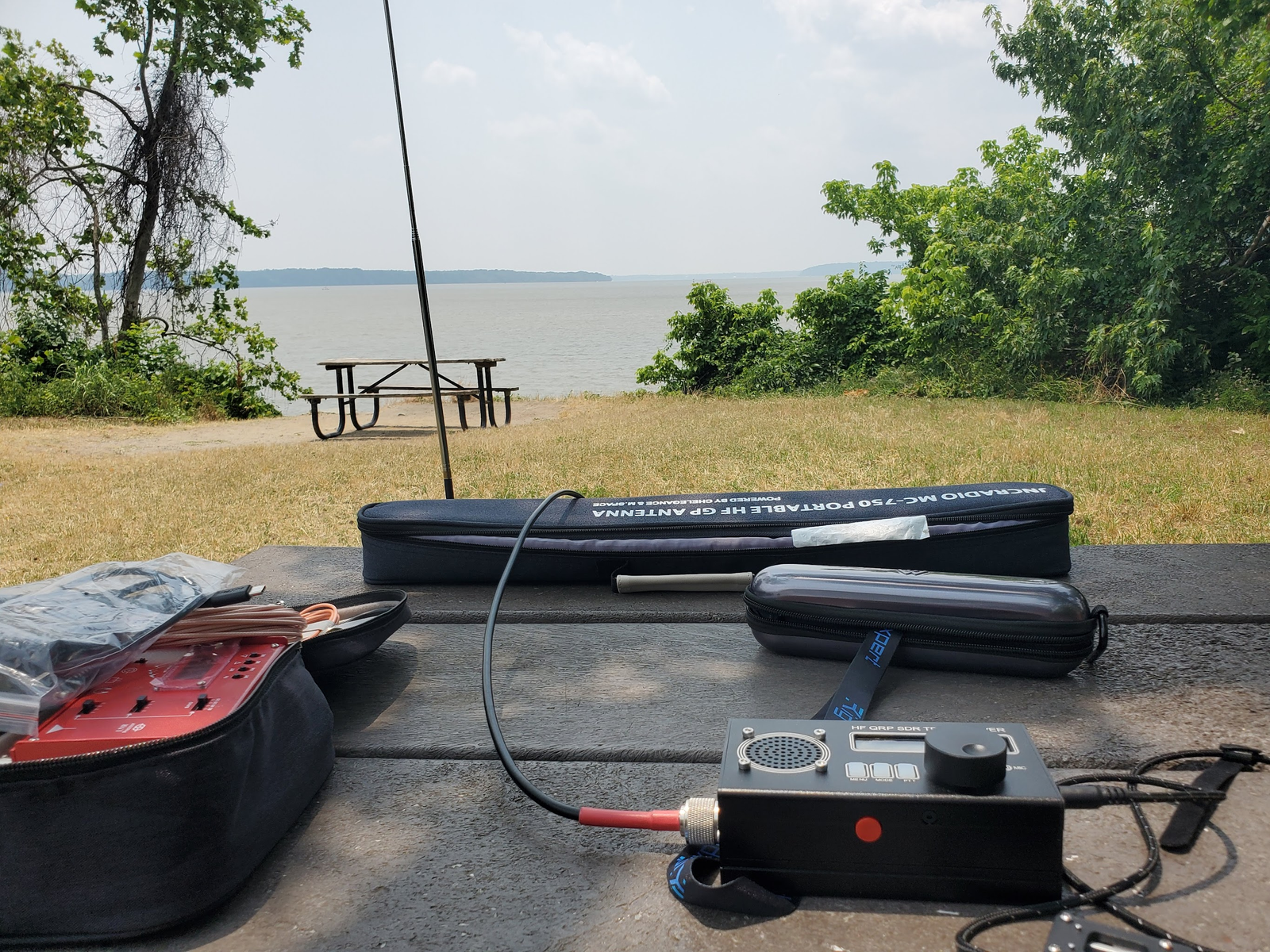
In preparation for an upcoming trip to Greece, I had been doing some field tests of my Mountain Topper MTR-4B and I had noticed that the receive audio on it was super quiet, to the point where it was getting hard to listen to signals, even with amplification. So I decided to try another rig that I had recently picked up to play with, a uSDX clone that I had picked up from the Banggood online marketplace in China.
I had purchased it for $139 on sale, and to be honest, I wasn't expecting great performance. Reviews online were mixed with some people having good results and others having issues. However, at that price, I was willing to take the risk and see if I could have some fun with it. And now, with my most portable radio having some issues, it was fortuitous that I had a backup.
The rig is capable of operating on 8 bands from 160-10m, has an internal battery, operates on CW, SSB, AM, and FM, has variable filters, and a surprisingly effective CW decoder built in. It claims up to 10W power output (I was getting about 7.5 in my initial tests), and while chunkier than the MTR-4B, it is surprisingly compact considering it has its own battery. Like other rigs of this size, it does not have an internal antenna tuner.
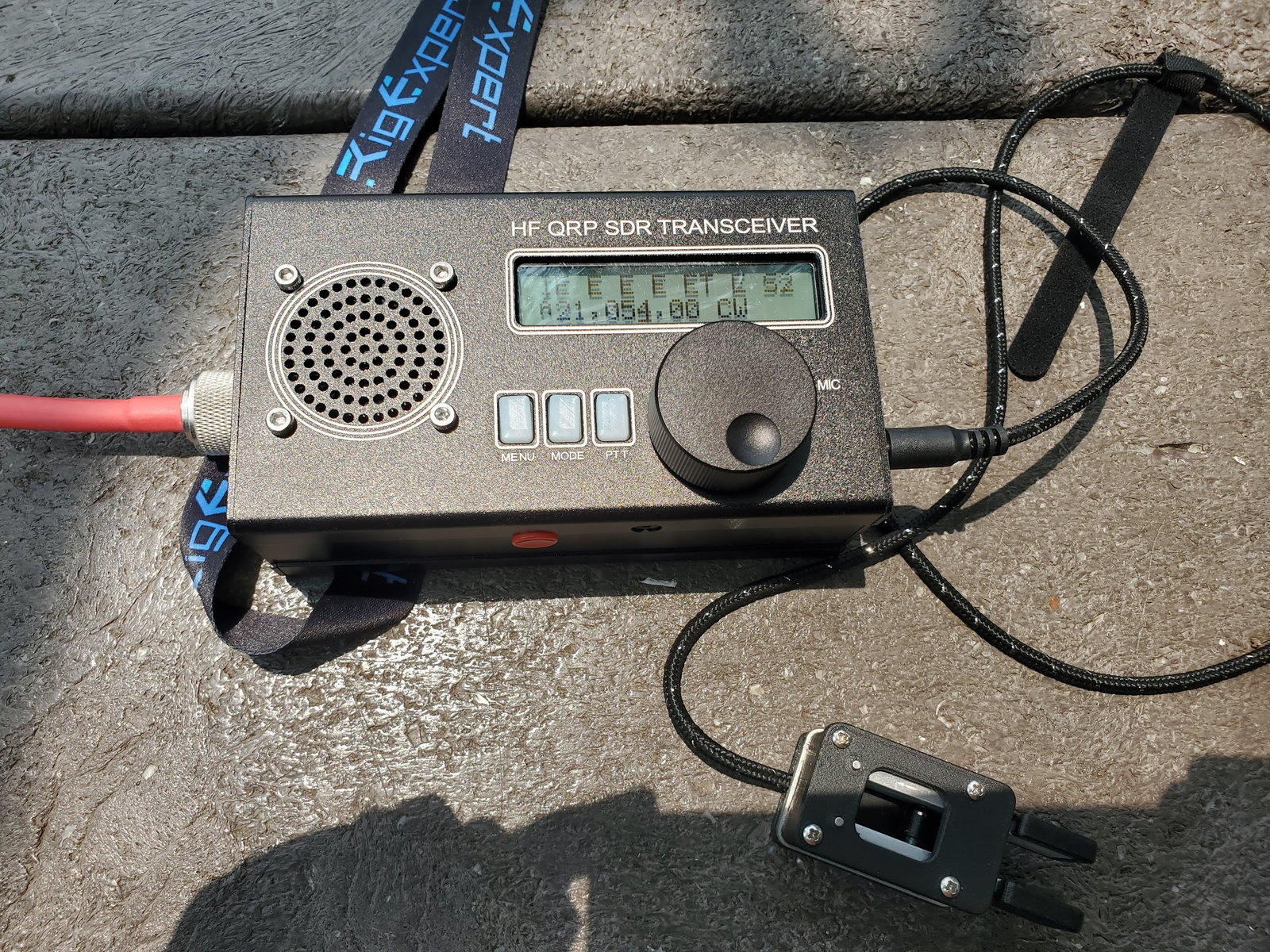
I had done some back yard work with the rig and had promising results, so I decided it was time to get it into the field for a POTA activation to test its mettle and see how it would fare under potential pile-up conditions. I decided to pair it with my Chelegance MC-750 so that I would not need to use an external antenna tuner (although I did bring one, just in case) and my N0SA designed SP4 POTA/SOTA Mini Morse Code Magnetic Paddles to give a real test of the entire setup I would likely deploy in Greece.
I was able to very quickly get a perfect match with my MC-750, and I noticed as I was preparing to spot myself that my good friend Ed, W4EMB was activating a park at that very moment. Naturally, I had to get him in the log, so I sent him a hello and got a solid signal report back from him. I thanked him for the Park to Park and told him he was sounding great on 20m from Tennessee, and then moved down a bit and found a clear frequency on 14.059 and started my activation.
Almost immediately, I heard back from a station in Arkansas, then I heard from another LICW friend, Rin, W4RIN in Georgia. Great as always to get him in the log. Then I made contact with Texas, Illinois, Wisconsin, Illinois again, Arkansas, Missouri, Florida, and Alabama. The rate wasn't super fast, but the rig was working well. I was getting mostly strong signal reports with a few weak ones in there, but it was working, and from what I could tell, it was working well.
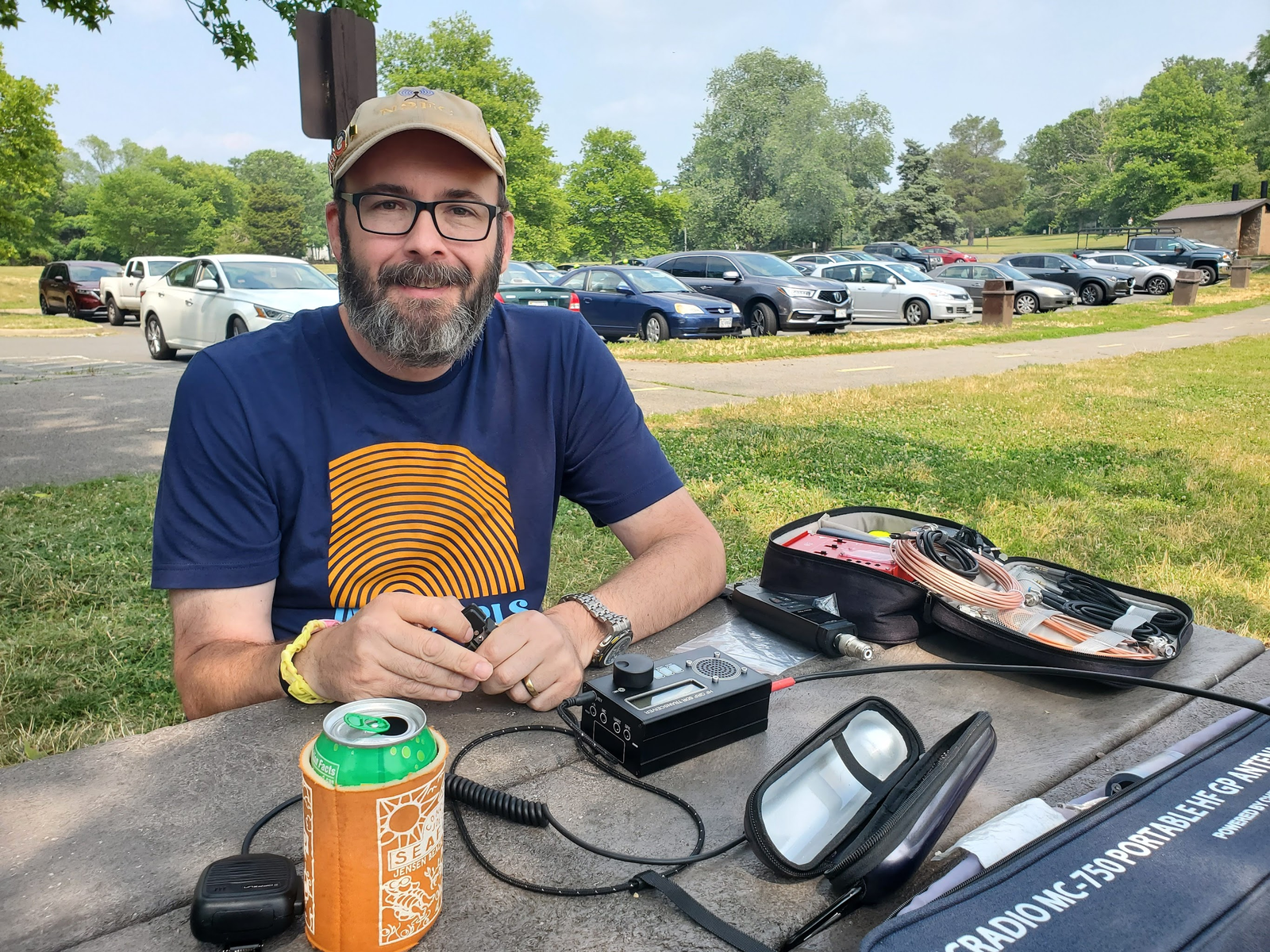
One of the advantages of this rig is the large number of bands available to me on it. The MTR does 4 bands (80m, 40m, 30m, and 20m), only 3 of which are actually useful in a field situation (I don't have any field capable 80m antennas). The uSDX adds some higher and lower bands to the mix, so I was excited to see what I could do with them.
I retuned my Chelegance MC-750 for the 17m band and began calling CW. For a while I didn't get any takers, but finally got a contact with Alabama where I received a 579 signal report and he was popping out a solid 599. After a bit more time with no responses I moved up to the 15m band and got Florida and Utah in the log before before moving down to the 40m band to see if I could get some more contacts. Interestingly enough, I just made one with a station in Ohio, who heard me at 449. After a while of calling CQ and hearing nothing I decided to move back to 20m.
First I decided to look at the spots and see if I could get another park to park contact, and I did with a station in Kansas, and then again with a station in Colorado. Then I decided to call CQ again and made contacts with Tennessee, Nebraska, and Georgia. After a bit of a lull, I hunted Park to Parks in Florida, Georgia, and Florida again. It turns out that each of them were in 2-fers (and I was in a 4-fer) so many P2Ps ensued.
I went back to calling CQ and heard from Florida, then got a second call from Ed, W4EMB, this time from his house also in Tennessee. After a quick chat telling him I was testing a new rig, I heard from Florida again, Wisconsin, Tennessee, Florida, Illinois, Florida, Illinois, and then my longest distance contact of the day with super hunter KJ7DT in Idaho (who heard me surprisingly well). Next up was Missouri, Tennessee, Illinois, Missouri, and finally Georgia.
I had tried a few times to make contacts on SSB for some park to parks ... but nobody heard me, so I'm guessing that there is something wrong with it on the voice side. I'll have to hook it up to the spectrum analyzer to see what's going on, but it works well on CW, and that's primarily what I bought it for.
My wife and daughter drove up and brought me some lunch and we had a picnic at my beautiful operating position on the banks of the Potomac River. By the end of the day I made 37 contacts on CW and had a lot of fun in about 2 hours and 39 minutes. It wasn't what I'd get at 100W, but it was a whole lot of fun with a station that weighs almost nothing. This little rig, which costs less than the antenna it was connected to, certainly did the job. Additionally, it did it entirely on its internal battery. Not bad at all.
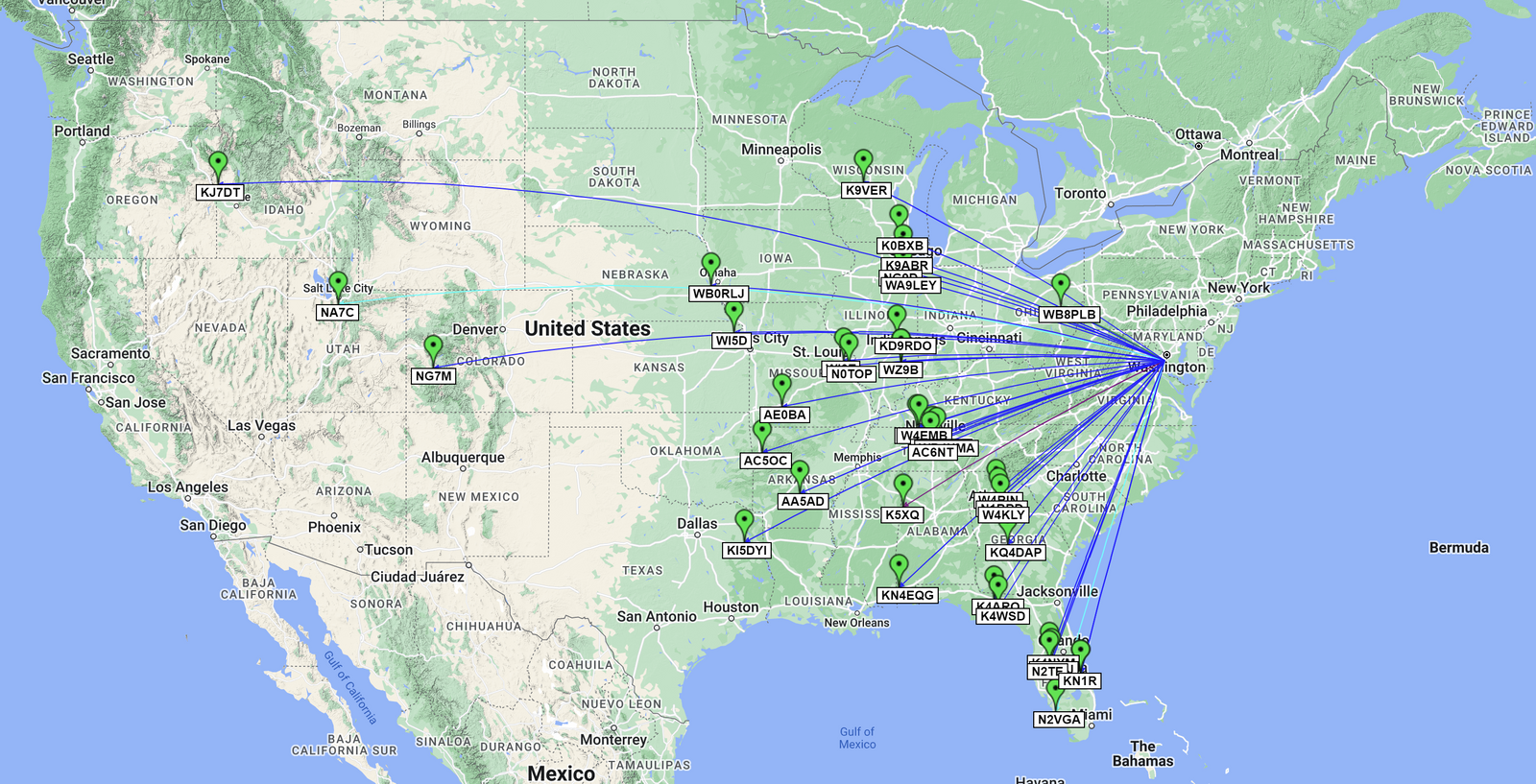
Activation QSO Map: Green Pins = CW / Green Lines = 40m, Blue Lines = 20m, Purple Lines = 17m, Cyan Lines = 15m
Gear used in this activation
- uSDX 8 Band QRP HF SDR Transceiver
- Chelegance MC-750 Vertical Antenna
- RigExpert Stick Pro Antenna Analyzer
- CW Morse SP4 POTA/SOTA Mini Morse Code Magnetic Paddle (N0SA Designed)
- Samsung Galaxy S10+
- HAMRS Logging App
Posted on June 20th, 2023
POTA Activation #61: A Post-Concert Wolf Trap National Park for the Performing Arts Activation (VA) (6/8/2023)
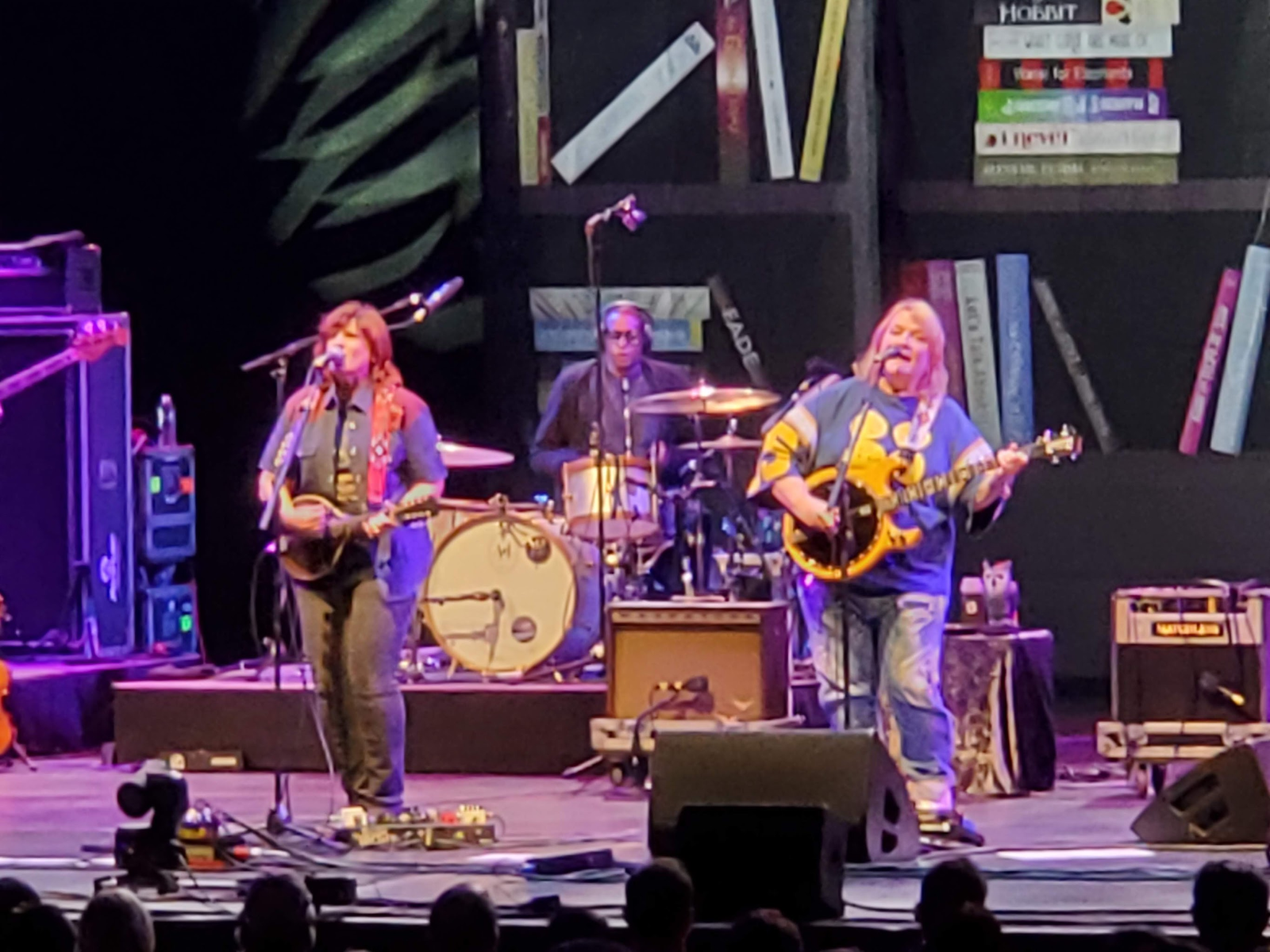
My beautiful wife has been on a bit of a concert kick of late, so she's been looking out for shows of interest that the family can enjoy together. She and I have been long-time fans of the Indigo Girls, so when she heard they were going to be performing at Wolf Trap she jumped at the chance to get tickets to the show for the three of us. Wolf Trap is a beautiful venue situated in Northern Virginia near Tysons Corner surrounded by a beautiful park.
You may be guessing where this is going ... Wolf Trap National Park for the Performing Arts just so happens to be the one and only National Park dedicated solely to the performing arts. It also happens to be one of the parks that is a part of Parks on the Air. So once we had tickets in hand, I was excited to see the show, and to get the park on the air as we waited in the long lines that always are present to get out of the parking lots after the show. For once waiting in a line was a feature and not a bug ...
The three of us arrived at Wolf Trap with time to spare on a pleasant late Spring afternoon from a temperature perspective, however, from an air quality perspective it left something to be desired. Due to wildfires in Canada, the air quality was quite terrible and the air was heavy with the vague smell of a campfire and the acrid byproducts of combustion. We made it into the Filene Center fairly quickly and after getting some snacks and souvenirs made our way to our fantastic seats a short distance back from the stage.

The show was excellent. Emily Saliers and Amy Ray performed all their hits and some of their newer material and the audience was enjoying every second as they were dancing and singing along to the songs they all knew by heart. The venue was nearly sold out and the hazy skies were unable to put a damper on the spirits of the thousands assembled. After a two hour set capped by a 3 song encore, the Indigo Girls bid us good night and we made the slow trek back to the car. I was excited to get an activation in the books from a new (to me) park, but looking at my watch I noticed that the show had gotten us past the eleven o'clock hour, and I worried that all the hunters might have called it a night already. There was only one way to find out ...
Since it was in the evening, I gravitated toward the 40m band, thinking that would give me the best shot of making my 10 while I waited for the parking lot to clear out at Wolf Trap. So I spotted myself, notified some friends, and called CQ. And then I called CQ again ... and again ... and again. Crickets ... is this thing on? Since I was using HAMRS, I saw spot after spot coming in on the RBN, but SDR receiving stations don't make contacts.
So I moved up to the 30m band and called CQ again. Wow, the spots really were coming in. I was killing it in Europe ... but it seems most of them were asleep. I kept calling, and silence was my only response. So I decided to move on over to the 20m band. As I was searching for a spot I heard A LOT of activity there. Quickly I realized I was in the middle of the CWops CWT, a regular weekly contest held by CWops for an hour where the operators who run tend to absolutely fly at speeds that can be in excess of 35wpm. Usually they hang out in the .028-.045 region, so I went a bit higher and started calling CQ POTA.

Where I was spotted on the RBN
For several minutes I heard no replies to my CQs. I contemplated calling QRT and going back to watching cars not move around me. Then I got my first reply. A station in Texas was hearing me at 559, so now if I called QRT it would be a failed activation. Time to redouble my efforts. Next I got another call, and then after 4 minutes a third, this time in Oklahoma. Then I had 6 minutes of nothing at all. Was this going to be my first failed activation? Looking at the RBN I was getting out like crazy across 3 continents ... they just weren't looking for me.
So as I was sitting there, I realized something. I had heard dozens of stations when I switched to the 20m band. The CWT was on. Then a light bulb went on in my head. Any QSO is a valid QSO for POTA. Hunters are hunters, even if they don't know they're hunters ... Contesters will work to make contacts with me if I call them, they want the QSO just as badly as I do. And the CWT has a quick and easy exchange just like POTA. If you can't beat them ... join them. And so I did.
Scrolling down the dial I heard a station in the Czech Republic blazing at the speed of light. I threw my call out and got an immediate response. 4 in the log. Next I heard a station from Alberta burning that paddle like the wildfires plaguing us all. I called him and boom, 5 in the log. Then I heard an Illinois station running at speed. Number 6. Next was a Texas station for 7, then some Hungarian DX for 8, Kansas for 9, and finally Georgia (the state, not the country) for 10. Not a second too soon, as the parking lot had started to clear and the Park Police were starting to circle the parking lot which meant that it was time for us to head on home.
With 12 minutes until midnight I called it an activation and got my 36th unique park on-the-air. It was certainly an unconventional activation, but a lot of fun. I didn't realize I could hang with guys going at double the speed I usually activate at, but I was able to get it done. Perhaps I'll participate in more CWTs in the future. A good reminder to not give up. Sometimes one operator's contest is another's activation. Dit. Dit.
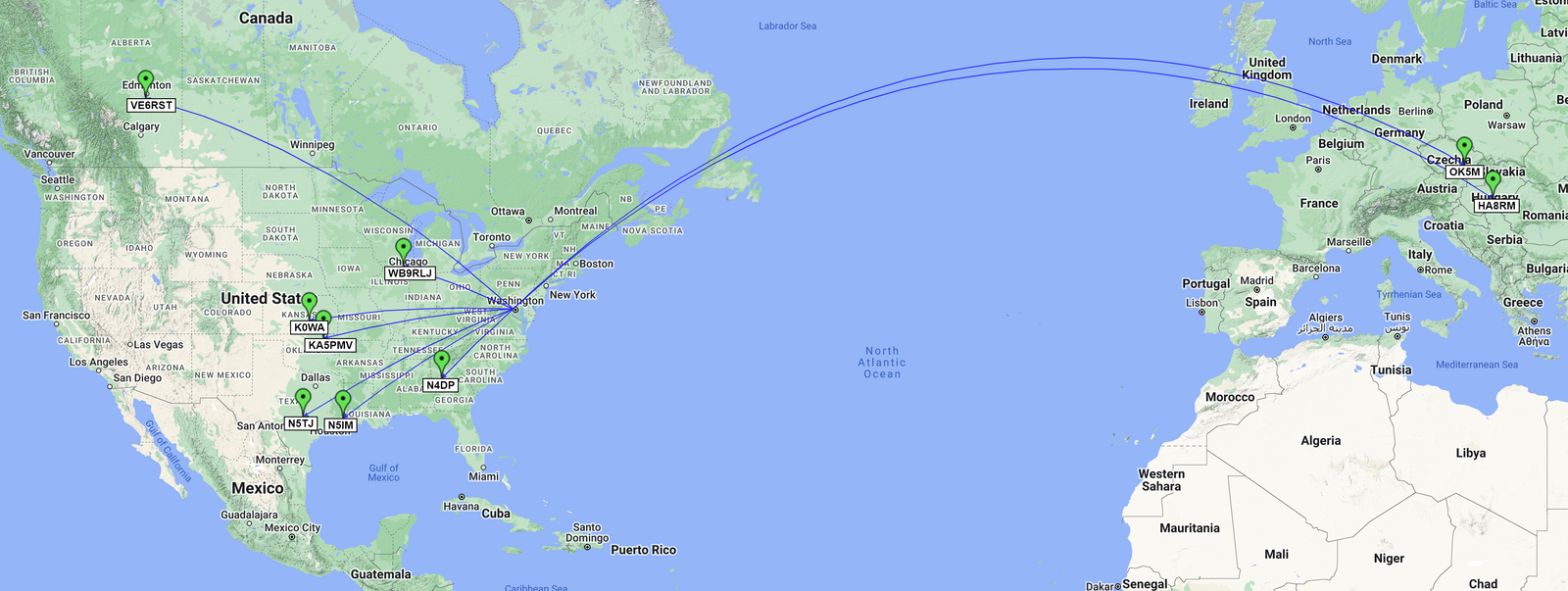
International Activation QSO Map: Green Pins = CW / Blue Lines = 20m
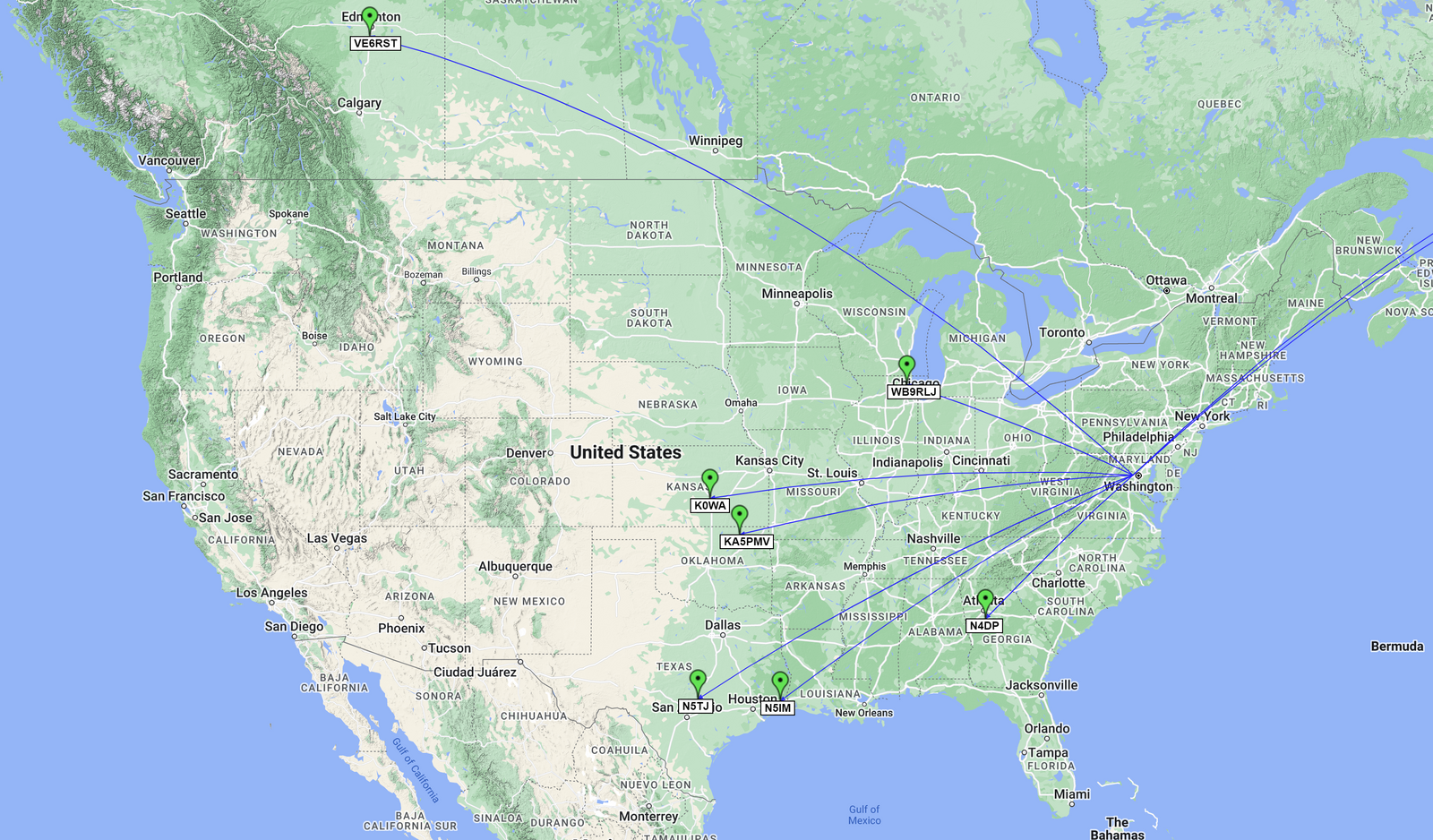
Domestic Activation QSO Map: Green Pins = CW / Blue Lines = 20m
Gear used in this activation
- Yaesu FT-891
- Yaesu ATAS 120A Antenna
- Begali Magnetic Traveler Light Iambic Key
- 2006 Honda Accord EX V6
- Samsung Galaxy S10+
- HAMRS Logging App
Posted on June 8th, 2023
POTA Activation #60: A Club 4-fer Activation and my first Kilo with Friends Old and New (VA) (6/3/2023)
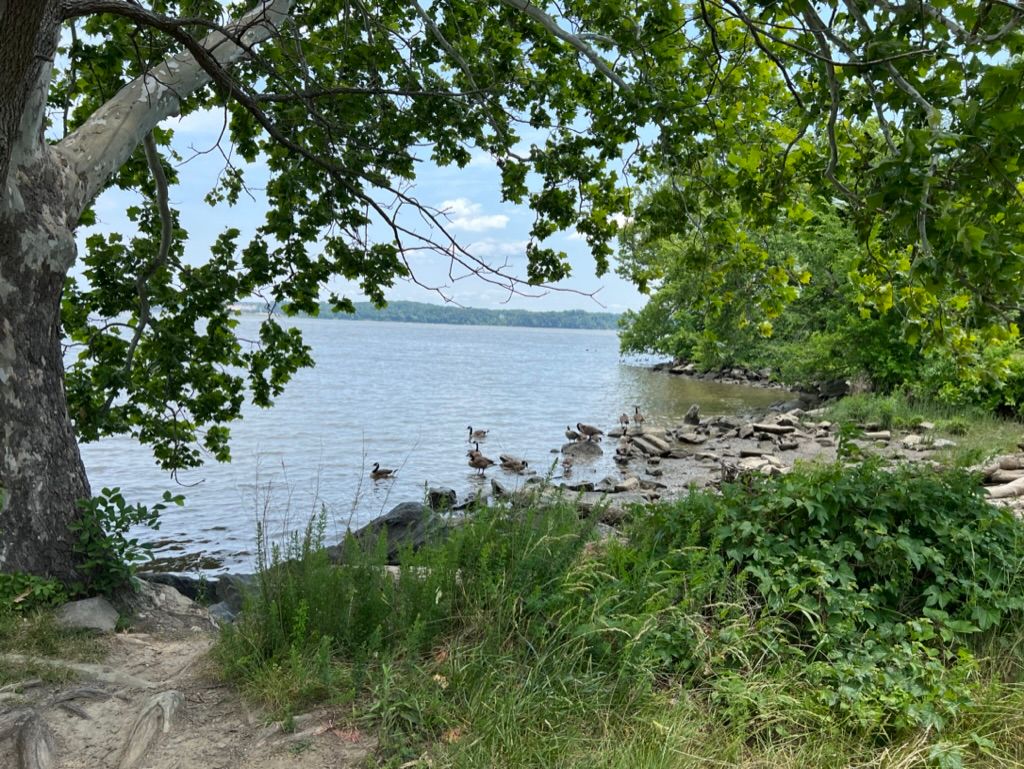
Photo taken by Corey Law, KN4YZY
Saturday, June 3, was a busy day in the world of Amateur Radio. Locally the Ole Virginia Hams club had their Manassas Hamfest which was attended by several MVARC members and across the airwaves the Parks on the Air Plaque Event was underway. It was also the day when the Mount Vernon Amateur Radio Club would have its very first activation for Parks on the Air. For the first time in several weeks, the weather was looking to be cooperative, so a message was sent out on the MVARC reflector inviting all interested in joining to Belle Haven Park in Alexandria to learn how to get antennas in trees and how to get on the air with Parks on the Air.
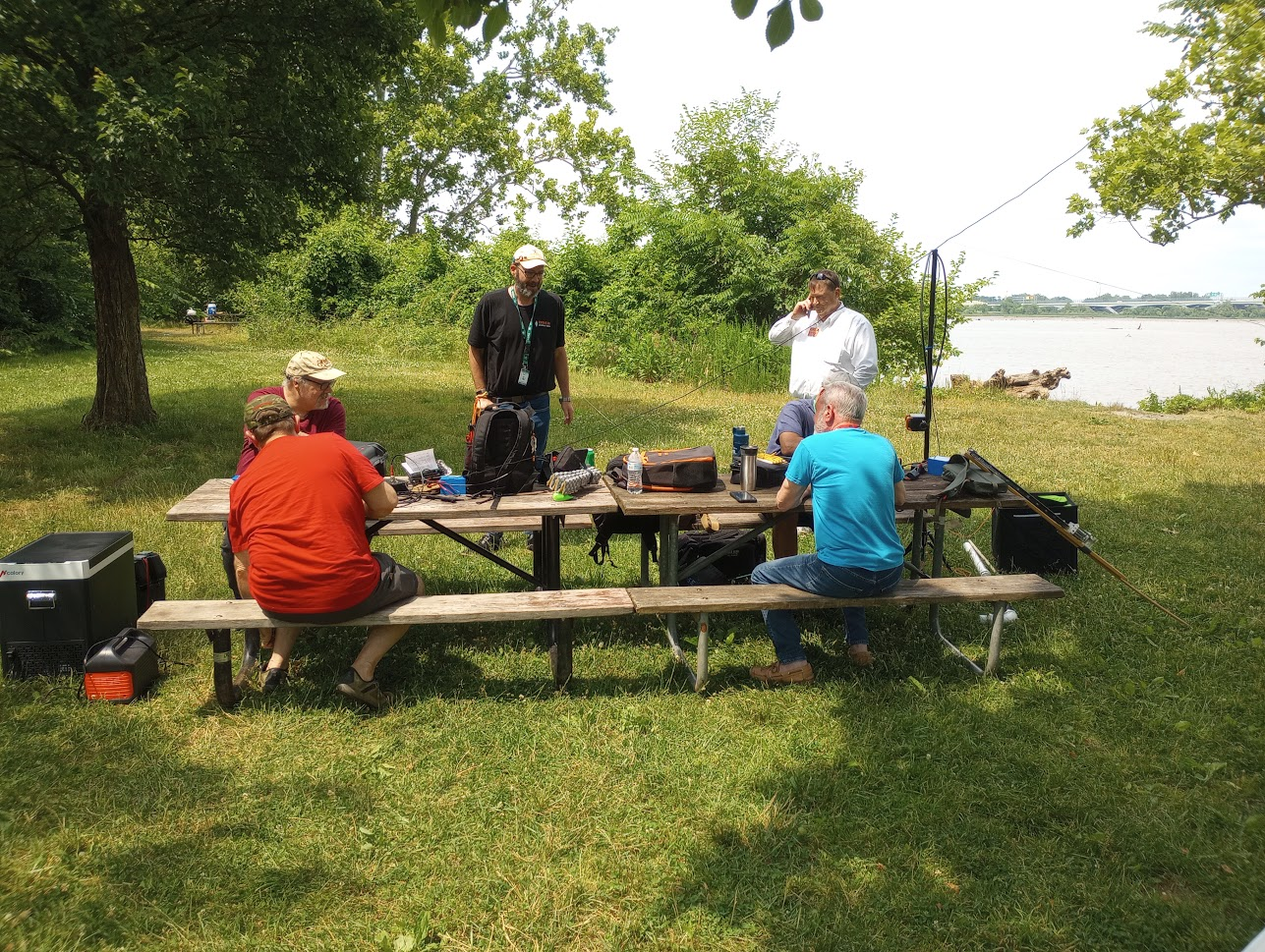
Photo taken by Greg Josephs, AJ4QZ
I wasn't sure how many people would join in the fun, but I was hopeful that the great weather and close-in location would get members out into the park. Gersohn, KO4IUK, was the first to commit to joining me, so after getting home from the Manassas hamfest, I made my way to Belle Haven Park. As it turns out, I wasn't the first person there. I was joined by Greg KC5QCN, the president of the Arlington Amateur Radio Club, who had already arrived and had set up his well appointed QRP station on a well shaded area along the banks of the Potomac. He had an FT-818 and a Chameleon Delta Loop already up and operational and gave me a hearty welcome as I arrived. He assisted me in moving some tables together so we could accommodate anyone else who joined us and helped me haul some gear I had brought, including my electric cooler with some cold sparkling water to enjoy.
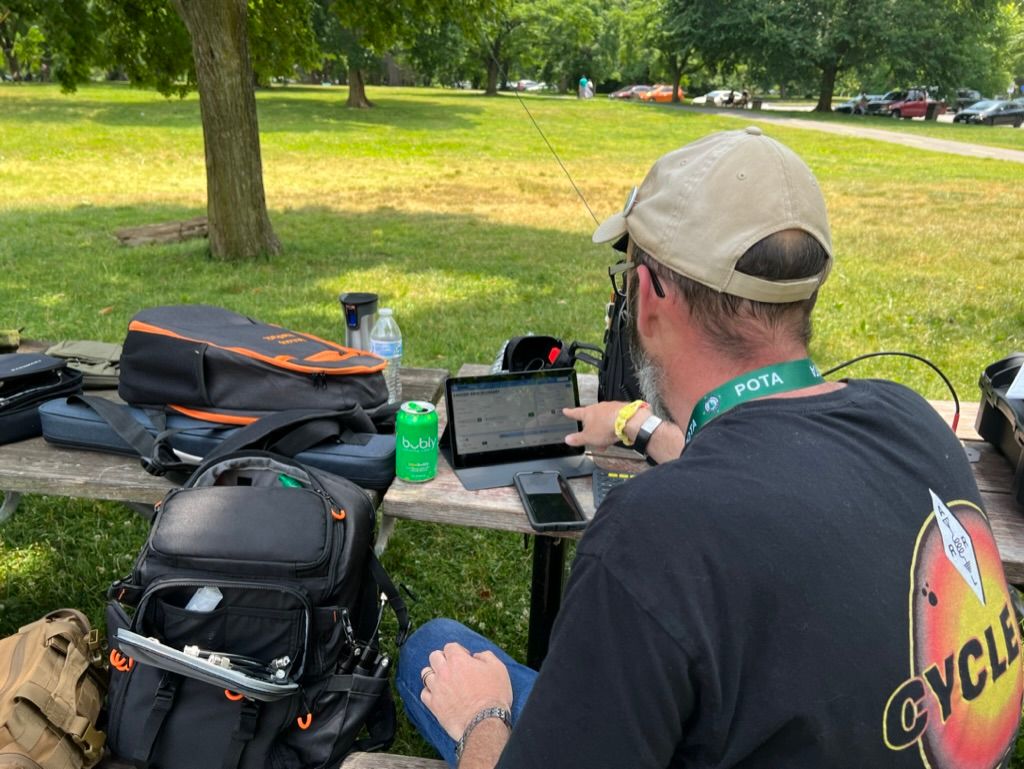
Photo taken by Corey Law, KN4YZY
I set up my Icom IC-705 and we were soon joined by Gersohn, KO4IUK, who set up his Lab599 Discovery along with his Chelegance MC-750 and AlexLoop Magnetic Loop Antenna. In short order we were joined by MVARC members Brian KQ4GWB, Corey KN4YZY, Greg AJ4QZ, and Bob KT4KS. Also joining us was friend, author, and fellow POTA enthusiast Larry KN4XW and Alexandria Radio Club President Don KI4D. Brian had also brought some gear, and with 10 of us at the park, the outing was already a big success.
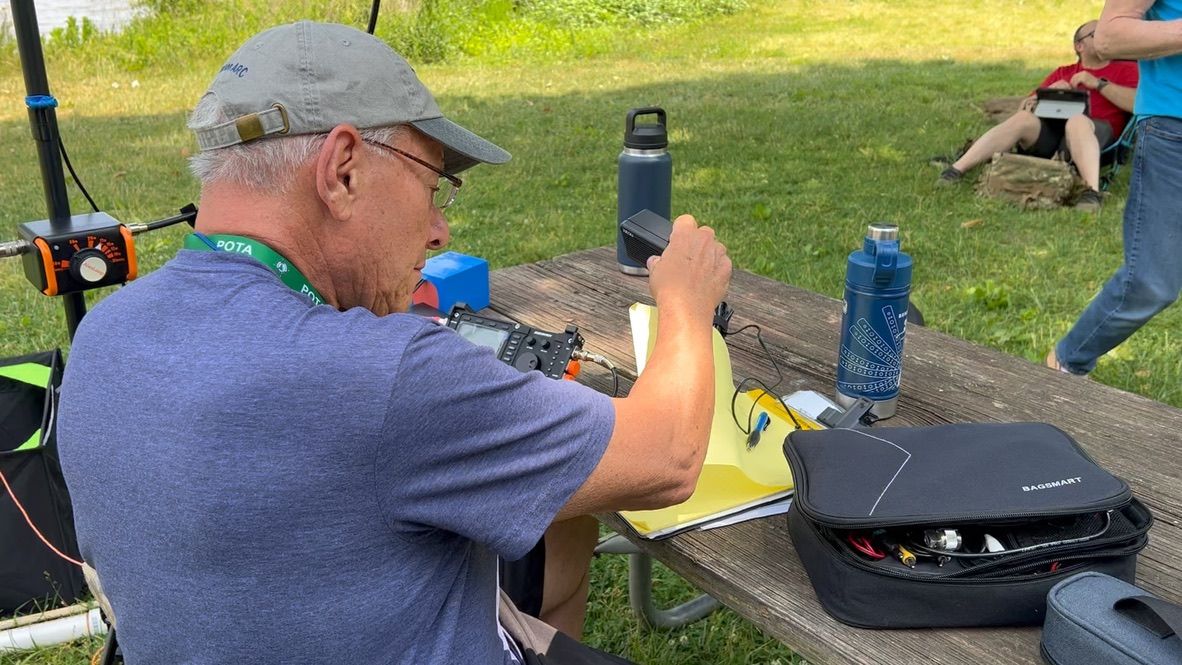
Photo taken by Corey Law, KN4YZY
Gersohn and I showed how to use an arborist throw line to get a wire antenna into a tree, both by swinging it with your arm and by using Gersohn's air cannon to launch it into the next county. Once we had an antenna up in the trees we took a look at the spots and saw that we were not alone on the bands, with over 160 other activators in parks around the globe. We decided to start on SSB, but were met with some surprisingly challenging conditions. We started on 40m and the going was slow. Our first contact was with North Carolina, followed by Ohio. Then we had radio silence. After a long time of calling and hearing nothing back I decided to move over to CW and see if we could get some more contacts in the log.
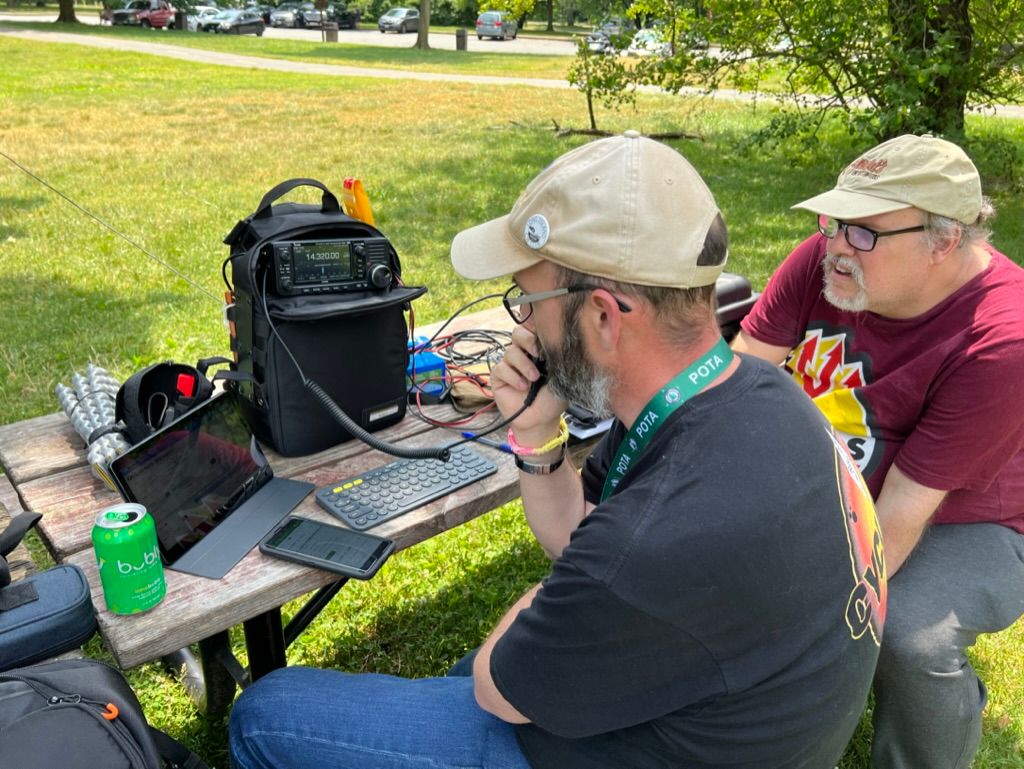
Photo taken by Corey Law, KN4YZY
In short order we got contacts with Pennsylvania, Virginia, another Pennsylvania station, another station in Virginia, New Jersey, Virginia again, Massachusetts, Virginia, New Jersey, Maryland, and Pennsylvania. Things quieted down, so I went to do some hunting on 20m and got YouTuber Kyle AA0Z in the log, and then I saw the big prize: KL7AC on 15m CW. I have gotten several calls while in a park from Alaska, but being able to hit a park in Alaska is quite rare. I tuned to his frequency and deep in the noise I could hear him with some fading, but definitely readable. I called him using the club call K4US and after a few calls, I got him. Then I switched to my own call and after a few fade-outs I was able to make the QSO and get into his log. It never ceases to amaze me what is possible with a few watts and a wire in a tree.

Photo taken by Corey Law, KN4YZY
While I had been making contacts on my 705, Gersohn had also been making contacts on his Lab599 Discovery using his AlexLoop Magnetic Loop Antenna and his Chelegance MC-750 Vertical Antenna and had made contact with stations in Massachusetts, Colorado, Slovenia, Nova Scotia (Canada), Florida (twice), Ontario (Canada), Nova Scotia (Canada) again, all on 20m. For the last contact of the day, he made a local contact on 2m simplex. All in all, we made 36 contacts while in the park and had a blast with club members and friends from other clubs as well. We'll definitely look to get out in the field as a club again soon.

Photo taken by Corey Law, KN4YZY
One last thing of note personally -- my contacts in the park this day took me past my 1,000th contact in the Captain John Smith Chesapeake National Historic Trail, so Parks on the Air awarded me my first Kilo award for the achievement. Lots of fun. Thanks to everyone who joined us -- I look forward to our next time out together.
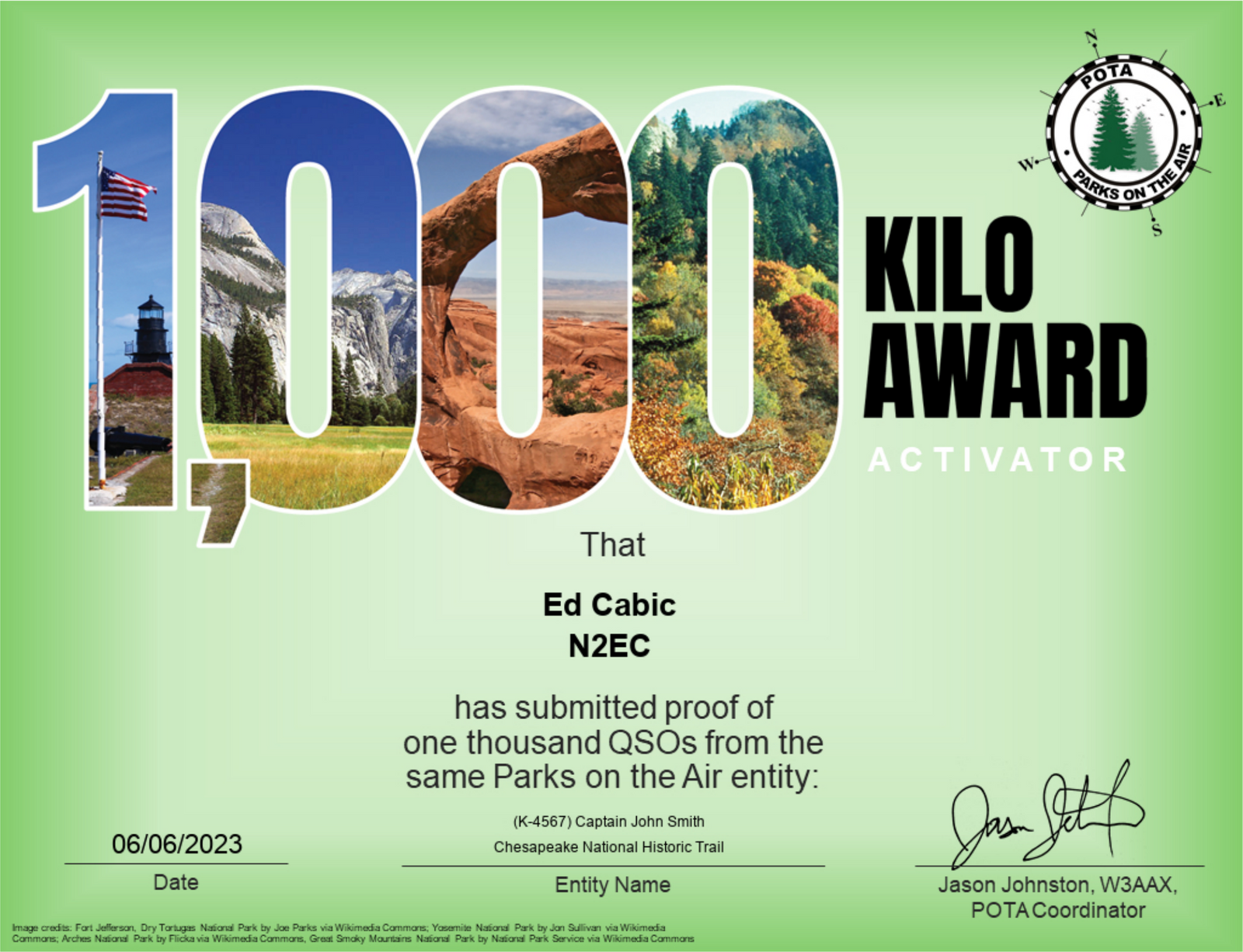
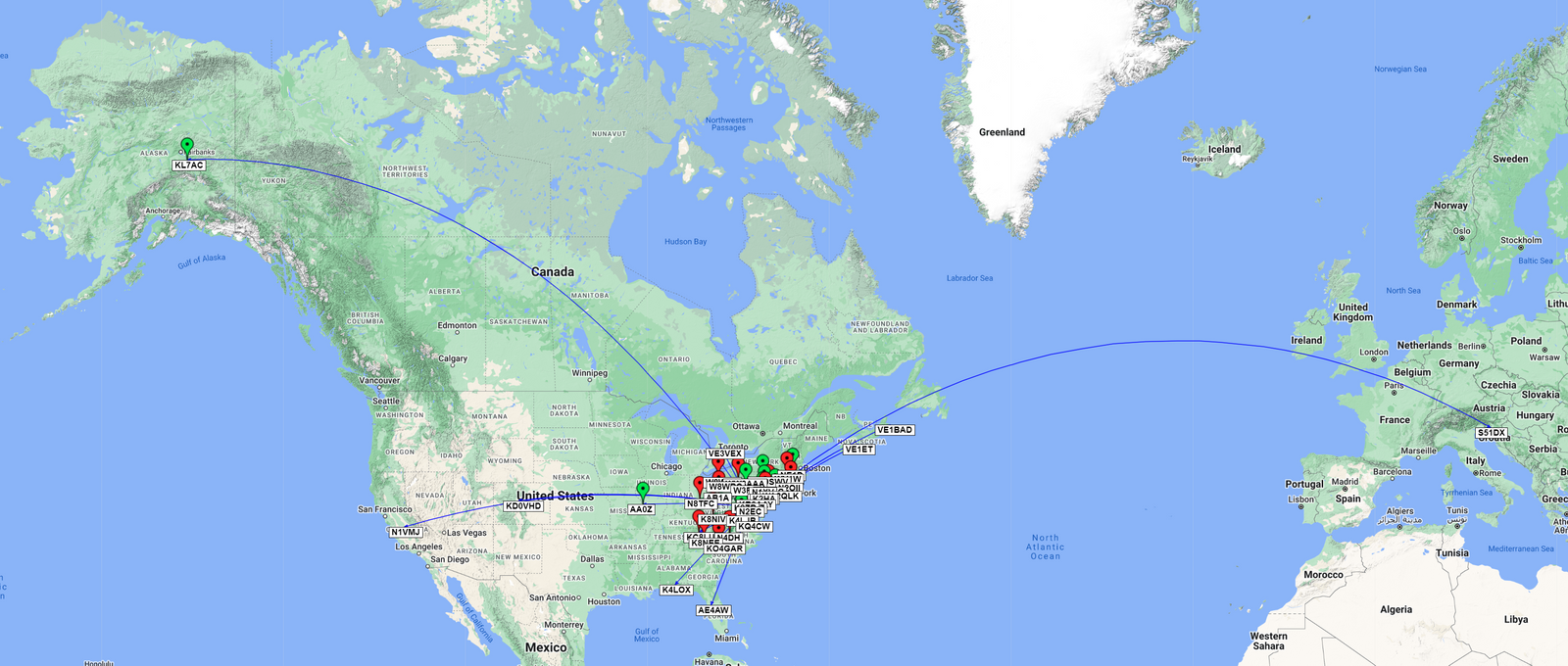
International Activation QSO Map: Green Pins = CW, Red Pins = SSB / Green Lines = 40m, Blue Lines = 20m
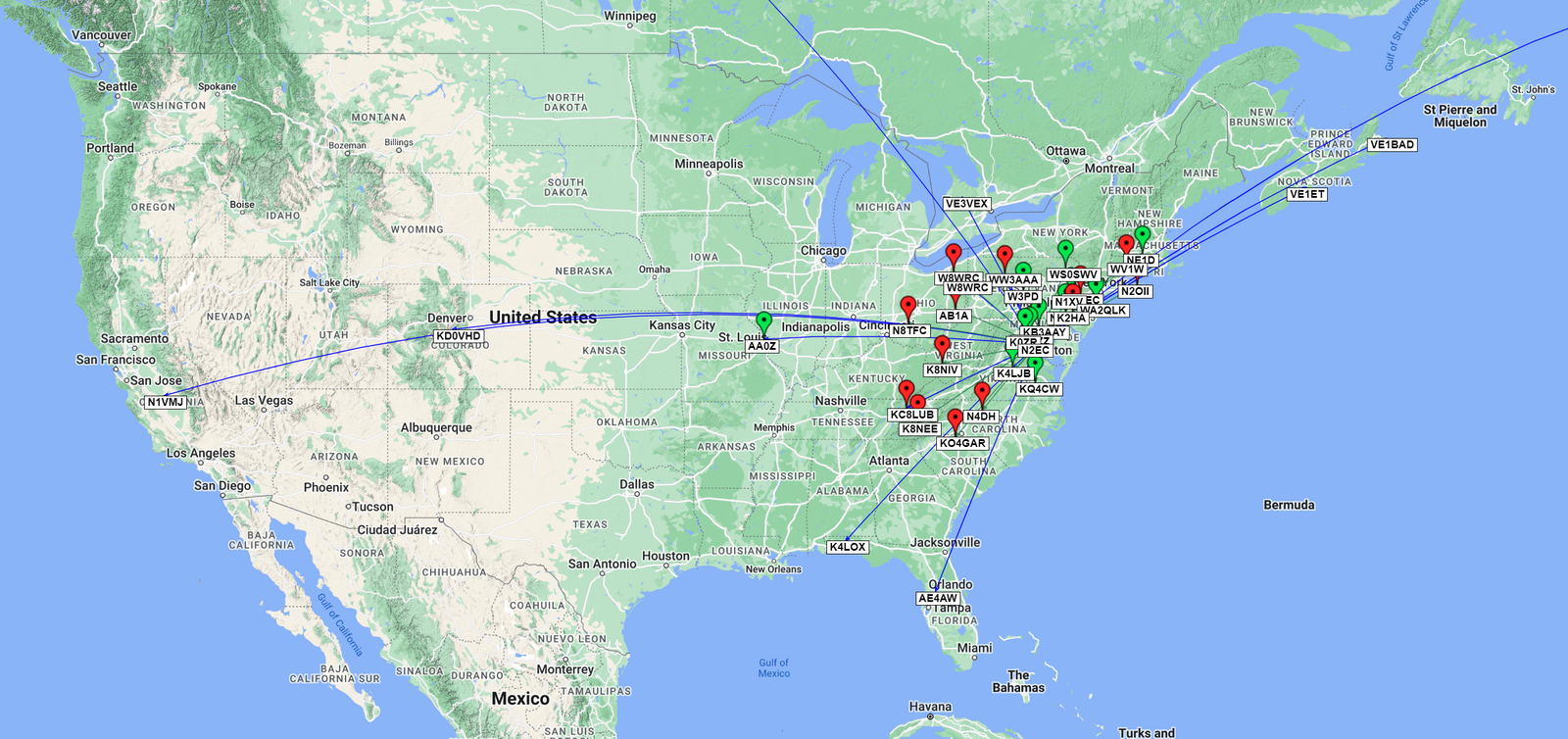
Domestic Activation QSO Map: Green Pins = CW, Red Pins = SSB / Green Lines = 40m, Blue Lines = 20m
Gear used in this activation
- Icom IC-705
- Laboratory599 Discovery TX-500
- MFJ 1984-MP End Fed Half Wave Antenna
- Chelegance MC-750 Vertical Antenna
- AlexLoop Magnetic Loop Antenna
- RigExpert Stick Pro Antenna Analyzer
- Begali Magnetic Traveler Light Iambic Key
- Icom LC-192
- Bioenno 12V 6Ah LiFePO4 Battery
- Samsung Galaxy S6 Lite Tablet
- Logitech K380 Bluetooth Keyboard
- HAMRS Logging App
Posted on June 6th, 2023
POTA Activation #60: A Before Work 2-Park 3-Band Activation With A New Begali Key (DC) (5/30/2023)
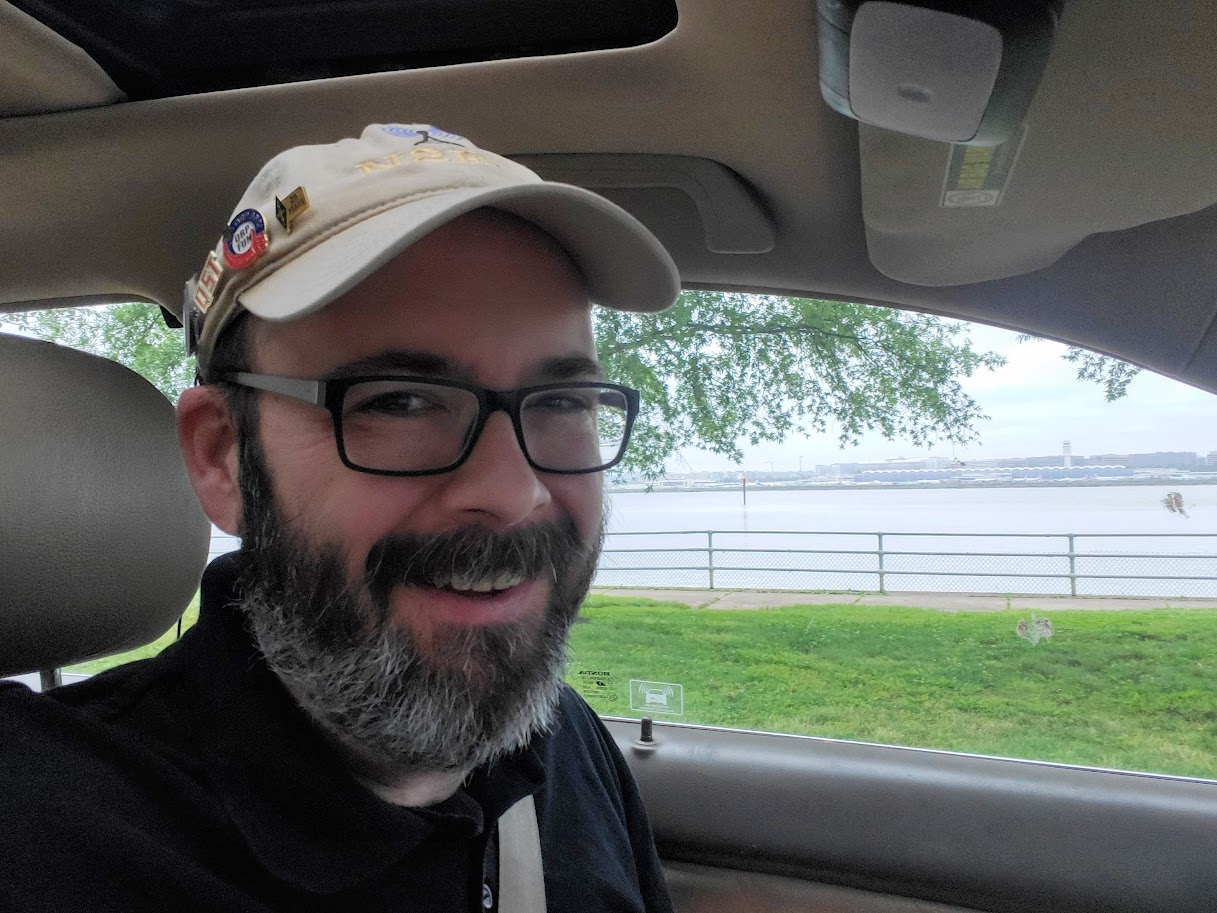
After a great trip to Dayton Hamvention, I had some new gear to get out into the field. Specifically, I had picked up a Begali Magnetic Traveler Light with an eye toward using it for my POTA activations. It was a significant investment, so I was glad I could give it a test at Hamvention to make sure I liked how it felt. Of course I loved it, so I purchased it from them and dreamed of many activations to come. I actually had my last activation after I purchased the paddle, but unfortunately, it was packed up with all my gear in the trunk since originally I wasn't expecting to do any CW for that one, so I used my CW Morse Pocket Paddle which was in my 705 backpack and easily accessible.
This morning I got up bright and early and today was the day for me to get some QSOs in the log for my beautiful blue Italian racer. Since I was activating mobile, I used the leg strap to attach it to my leg. I actually did this before I left the house so I could see how comfortable it would be and how stable the strap was. It was solid as a rock and quite comfortable with enough friction from the strap that I didn't have to tighten the strap too much. I also liked that the movable paddle guards acted as a "safety" of sorts so that while I was listening to CW on the way into work (this morning a weather net on 40m) I didn't have to worry about accidentally bumping an errant dit or dah onto the air.
Traffic was moderate, but I had gotten up with plenty of time to spare, so I enjoyed hearing weather from around the country on the way in and enjoyed how it made the traffic seem to go by faster. Finally I made it to my activation site, sent a note to some LICW friends, got myself spotted, and got on the air on 40m.

It took a few CQ calls, but eventually I heard back from Illinois with a 559 both ways. From there I had to call from a really fun call in Massachusetts that showed me there might be magic yet in the ionosphere, WI1ZRD. Next up the pace quickened and I heard from North Carolina, Georgia, Virginia, Ohio, Pennsylvania, Tennessee, Kentucky, and North Carolina. Then I heard my buddy Ed, N2GSL, just off frequency with a distinct pitch from LICW in New York. In the clear he was a good 559 and he later told me that he was working his Heathkit HW-9. I noticed a hint of drift in his tone, so he must have turned it on recently, but he was loud and clear running QRP and sounding great. Always a good start to the day when I get Ed in the log.
Next up I heard from Pennsylvania, Indiana, Michigan, Ontario, Virginia, North Carolina, North Carolina again, Indiana, Virginia, North Carolina, Michigan, Pennsylvania, and finally Ohio. Then things got quiet and I decided to move on up to the 30m band. The band seemed a bit noisy, but I still wanted to give it a go. I had to call CQ for a few minutes, but eventually heard back from Missouri and Georgia with some weak signal reports, then I was heard more strongly in Massachusetts and Michigan. Then I was delighted to hear a familiar call, K5KHK, who I met briefly at Four Days in May. Great to get Karl in the log again. Then I heard another familiar, LICW member, YouTuber, and Cootie enthusiast K9NUD. Great to get him in the log as well. After that contact things died off on 30 so I decided to make one more band change to 20m and give the band a try before I had to head in to work.
My first contact was with Georgia where I wasn't coming in too strongly, but we got it done. Then was Michigan where I was coming in a bit stronger for a repeat hunter -- thanks N8BB for finding me on another band! Next I contacted a pair of stations in NY, followed by KJ7DT in Idaho giving me my longest contact of the day. I always love when I get to work Paul - he's a great hunter and I always get a kick out of working Idaho. Finally I got one last contact with Missouri and I noticed some QRN was building on the frequency I was on. I moved to another frequency 6 KHz up, but got no takers after an RBN re-spot. Looking at the clock I realized it was time to go QRT and make my way into the office.
At the end of the activation I had 36 QSOs in the log in 51 minutes on the air on 40m, 30m, and 20m. The Begali Magnetic Traveler Light performed valiantly, and it was nice to have it strapped to my leg so I didn't have to hand hold the key as I have done for many previous mobile activations. I had a few mis-keys as I was getting used to the feel, but for the most part it went smoothly. The keying was pleasingly tight as adjusted from the factory and I can't wait to get some more QSOs in the log with it soon.
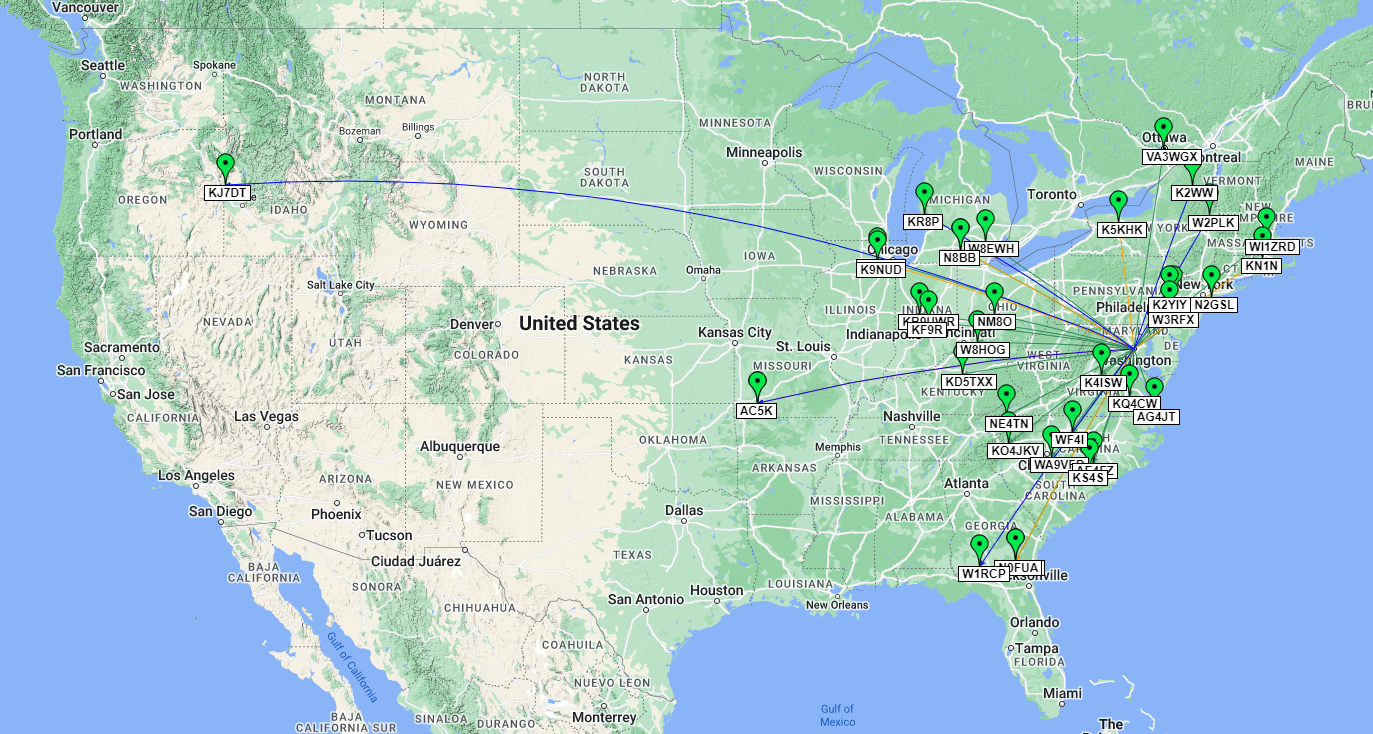
Activation QSO Map: Green Pins = CW / Green Lines = 40m, Orange Lines = 30m, Blue Lines = 20m
Gear used in this activation
- Yaesu FT-891
- Yaesu ATAS 120A Antenna
- Begali Magnetic Traveler Light Iambic Key
- 2006 Honda Accord EX V6
- Samsung Galaxy S10+
- HAMRS Logging App
Posted on May 30th, 2023
POTA Activation #59: A First Ohio Activation Returning from Hamvention at Buckeye Lake State Park with Gersohn and Nick (5/21/2023) (OH)

After a fun trip to Four Days in May and Dayton Hamvention, my buddy Gersohn, KO4IUK, and I made our way back home. While at Hamvention on Saturday, we met up with Nick, AJ4YB, a member of MVARC who recently moved to the Columbus area. While exploring Hamvention together we came up with a plan to meet up Sunday morning at Buckeye Lake State Park which was conveniently situated near Nick's QTH and also just off Interstate 70 on our way back home. Gersohn and I set the alarms for an early start and after having breakfast and packing up the car, we were off to the park. I had been hearing reports from friends that the bands were in bad shape the previous day. I had a friend who had a failed activation on the WA/OR border, although from the pictures I saw later on, it was a failure only in not getting 10 contacts ... his operating environment could not have been more beautiful, being on the banks of a lake with a mountain visible in the distance. So with no small amount of trepidation, we made our way to the park with some new equipment in tow to give a 3-op activation a try.
Gersohn was lucky enough to get one of only two Chelegance MC-750 verticals that Chelegance had on display at Hamvention. Reviewers including Thomas, K4SWL, have been singing the praises of this design, which features a collapsible whip with screen printed markings to aid in tuning. The display unit had a damaged 4th ground radial that we didn't have the tools to fix, so we made do with 3. Even with that 25% reduction in the radial field, we were able to get excellent SWR on the bands we tried almost instantly. With my RigExpert Stick Pro zeroing in on the perfect point of resonance was quick and almost effortless. For a radio we decided to use my Icom IC-705 as it has proven to be a capable performer in the field and very easy to use.
Nick arrived at the park shortly after we did on his motorcycle, and we showed off the new equipment while setting up camp on a picnic table on a creek that fed into Buckeye Lake. It was a beautiful morning and once we got everything set-up we decided to set ourselves up on 20m and hoped for the best. Scanning through the bands we saw a few stations on the waterfall, so we were hopeful and we spotted and called CQ on 14.312. It took several CQs, but after a while we got our first taker, a call from Colorado who boomed into our park with a 59 and heard our 10 Watt signal at 55. We then hopefully signed with a QRZ ... but our hopes were not met with success. Instead they were met with silence. We tried for a while, then switched to 40 m, where we got no callers for our efforts. After no luck on 40 m we returned to 20 m on 14.322 and let our recorded CQ save our voices. 19 minutes after our first CQ, we got a call back from a station in Louisiana, again at 59 for us and 57 from his side. Then we kept going and got no callers for another 19 minutes.
It looked like we were going to have a failed activation, so Gersohn and Nick insisted I do some CW to see if at least one of us could make some contacts, so I set up on 40 m at 7.044 and the calls started coming in. A pair of callers from North Carolina started things off with strong signals, then Tennessee, super hunter K9IS in Wisconsin, Virginia, Connecticut, super hunter Joe N3XLS in Pennsylvania. Then things stopped dead on 40, this activation didn't want to be complete. So I decided to go back to 20 m and I heard a quiet station who gave me a 339 in Texas and a pair of strong stations in Florida who got me to 12 QSOs and a successful activation with 10 CW QSOs in 17 minutes. If you need a reason to learn CW ... this definitely isn't a bad one. Gersohn and Nick needed 8 more and I didn't want to give up so easily. So we went to 14.320, spotted ourselves and gave it another go.
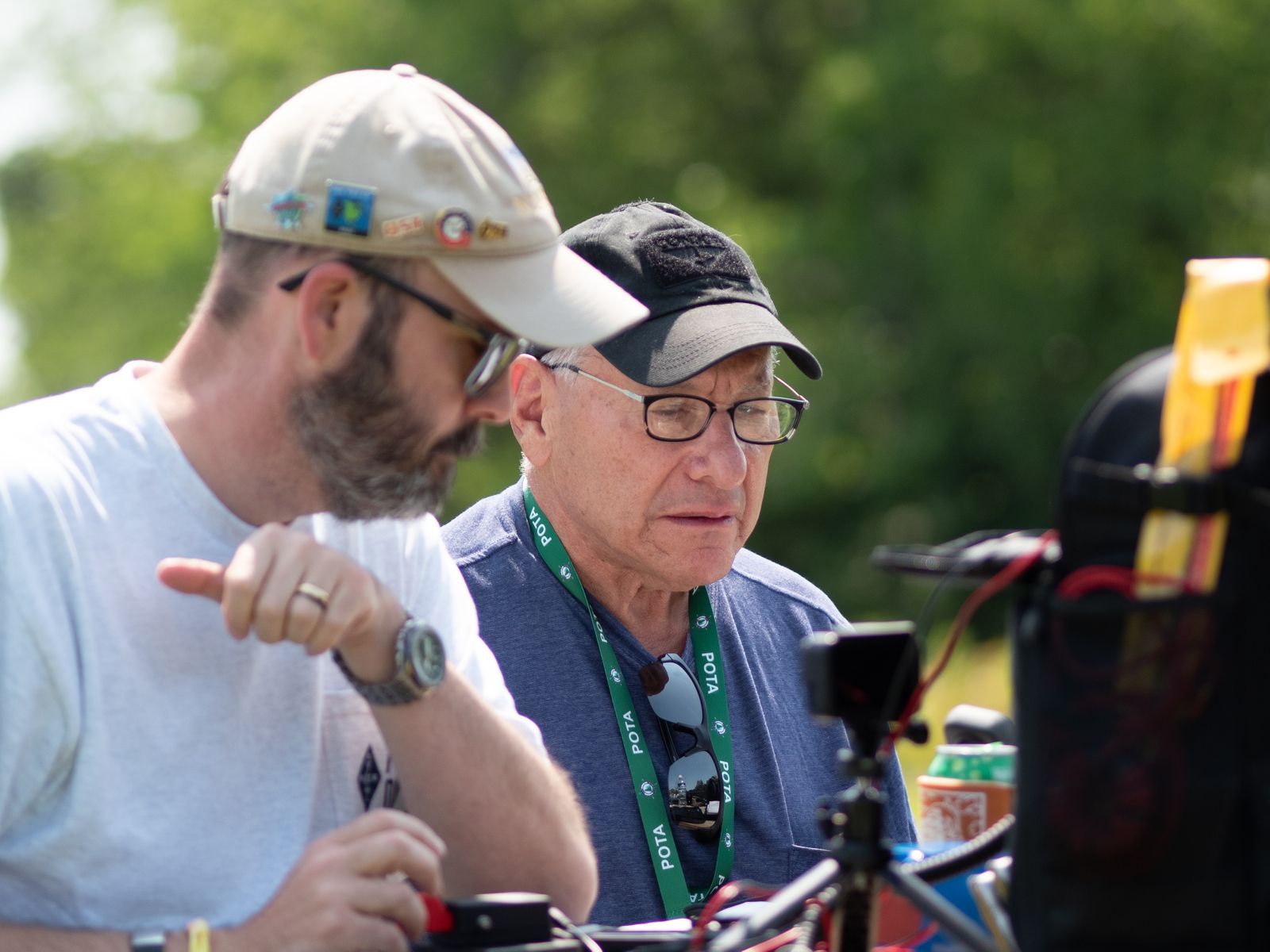
(Photo Taken by Nick Bloom, AJ4YB)
We heard from Rhode island first (SSB #3), then after a few minutes got a caller from Florida (SSB #4), and after 5 minutes heard back from a station in Pennsylvania (SSB #5). Interestingly, while the QSOs were slow and far-between we were getting solid signal reports and strong signals. We were getting close enough to be able to start doing some inside-the-park park-to-parks. Since we had 3 ops, each person could get 2 P2Ps on each band. Not the way we like to do things, but with only 5 needed we could do one 20m QSO, 2 on 2m, and 2 on 70cm and get it in the logs. Interestingly enough I had a conversation the previous day with Jason W3AAX, the founder of POTA, about this and my general reluctance to do it on anything other than 2m/70cm. He said in no uncertain terms it was okay, so I made my way to the mobile station to get one more HF contact before switching to the HTs. As I tuned to the frequency on my 891 I heard Gersohn chatting with a mobile station, just a few miles a way going down Interstate 70. They were surprised they got us on ground-wave -- they must have been super close (so alas their map locations are incorrect). I shut off the 891 and ran back to our operating position. The POTA gods smiled on us and the car had 3 ops in it. All 3 of us made contacts with all 3 of them for SSB contacts 6, 7, and 8. We thanked them profusely and now all we needed to get 10 was for each of us to make a contact on 2m. So we pulled out our HTs and called CQ POTA. We got no other takers than the ones we could see across the field from us, but that got us up to FM contacts 9 and 10. A successful activation for everyone.
From first QSO to the last we were on the air for 94 minutes. I got 20 in the log and Gersohn and Nick got 10. More importantly, the three of us had a great time together and Nick got his first POTA activation in the books. I had to reassure him that they're usually easier than this, but we still had a blast. We also got to test out that Chelegance MC-750 antenna and it was an absolute joy to use. While many of my antennas can theoretically go without a tuner, this is the only one that I can confidently say doesn't need one at all. I may have to pick one up myself.
After staying in the park longer than expected, we had to make our way back to the road. So Gersohn and I gave best 73 to Nick and headed back to Interstate 70 for home. We had initially planned on activating in Pennsylvania to get another state on the board, but with conditions like these we decided getting home before dark was the better plan. That will have to wait for another trip. Even with challenging band conditions, there is nothing like activating POTA with friends.
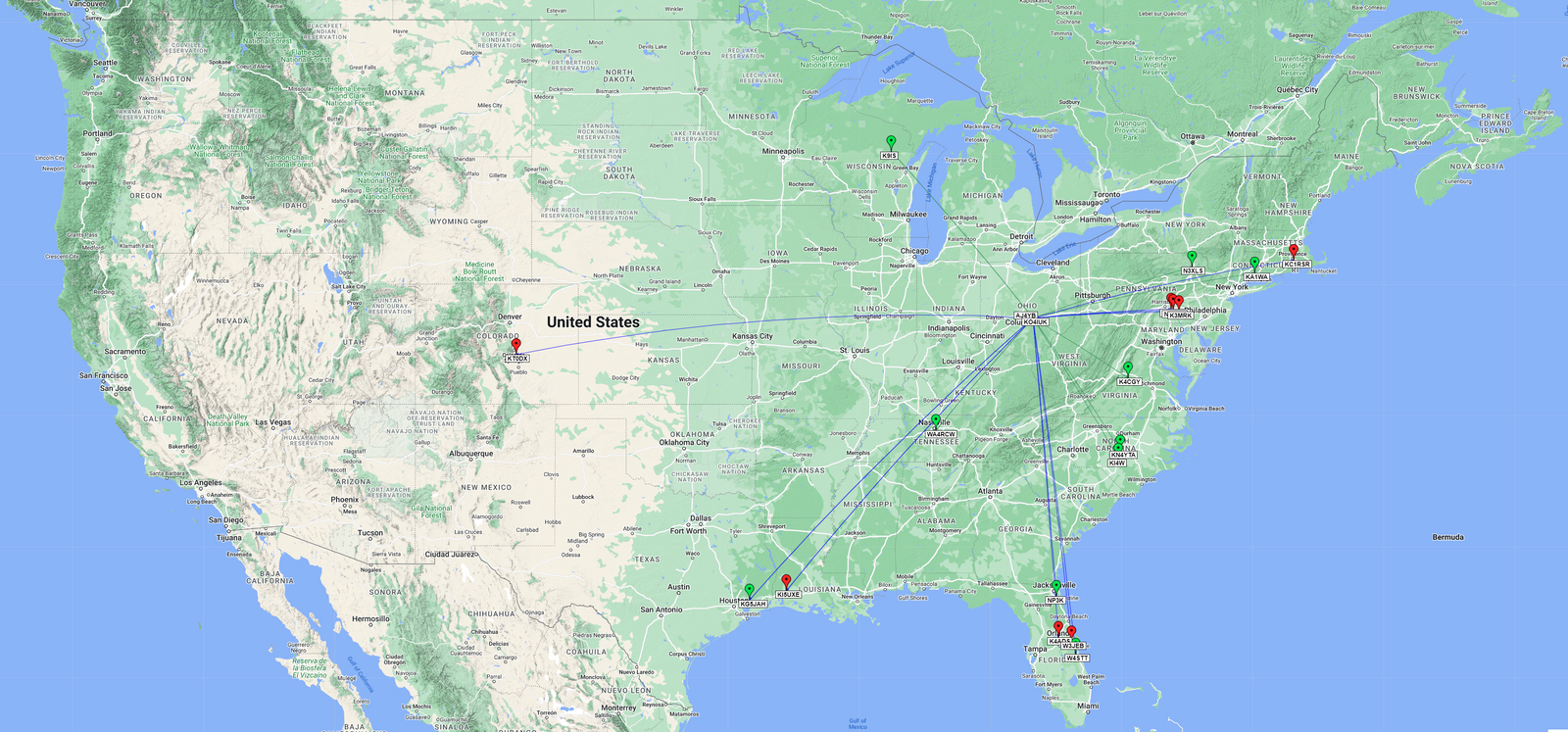
Activation QSO Map: Green Pins = CW, Red Pins = SSB, No Pins = FM / Green Lines = 40m, Blue Lines = 20m, Yellow Lines = 2m
Gear used in this activation
- Icom IC-705
- Chelegance MC-750 Vertical Antenna
- RigExpert Stick Pro Antenna Analyzer
- CW Morse Pocket Double Paddle Morse Code Key with Magnets
- CW Morse Steel Base for Pocket Paddles
- Icom LC-192
- Bioenno 12V 6Ah LiFePO4 Battery
- Samsung Galaxy S10+
- HAMRS Logging App
Posted on May 24th, 2023

